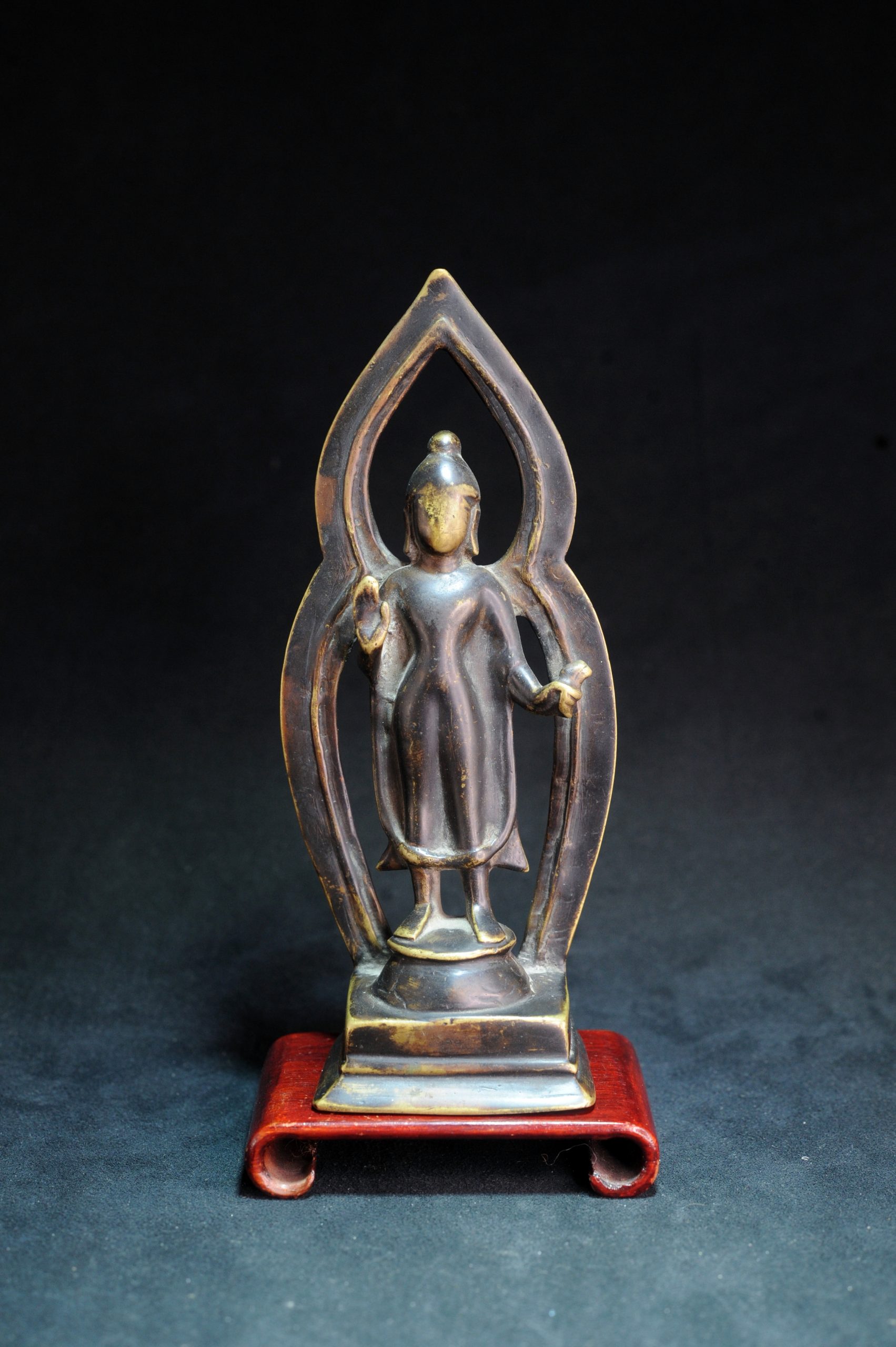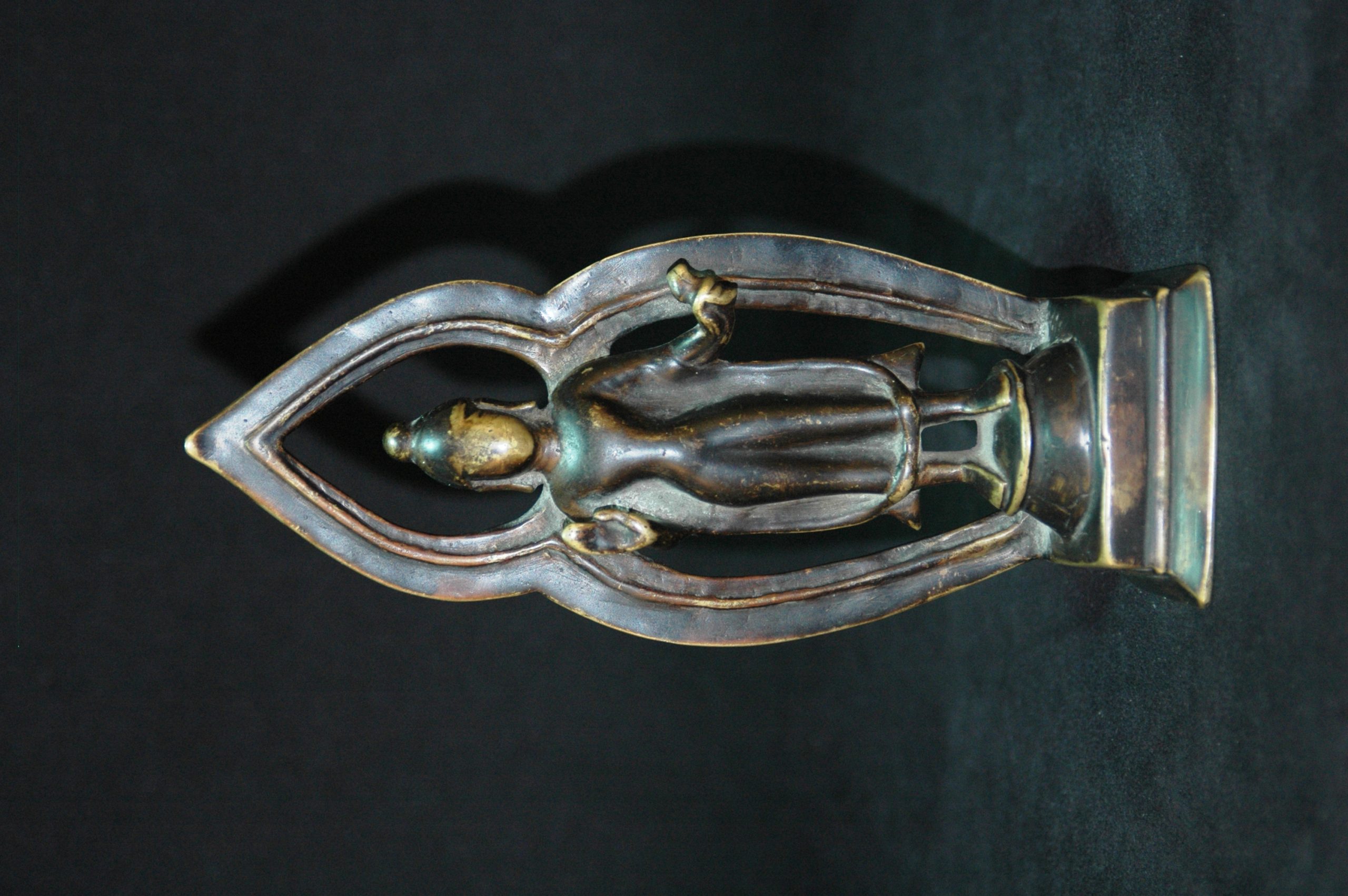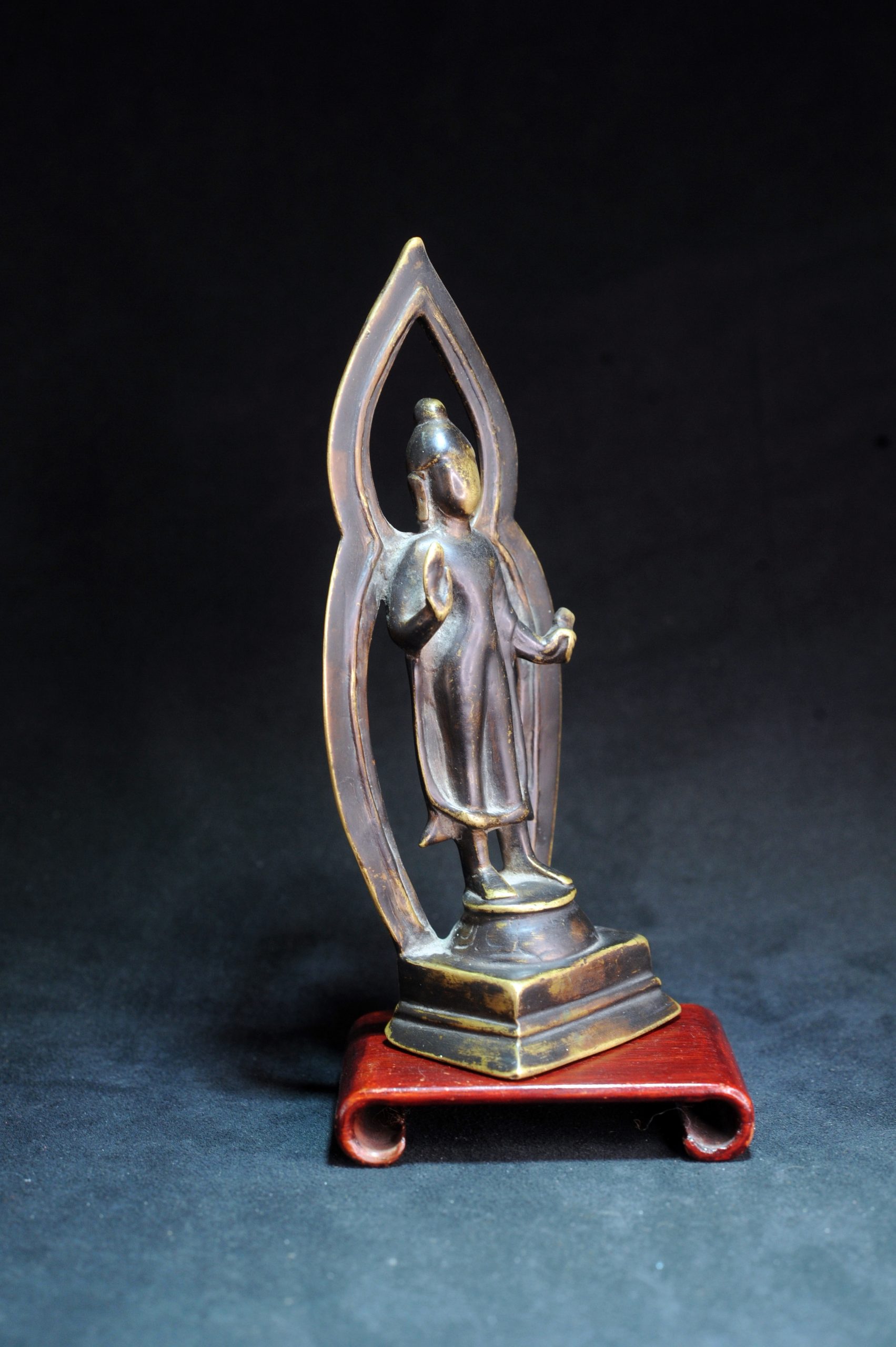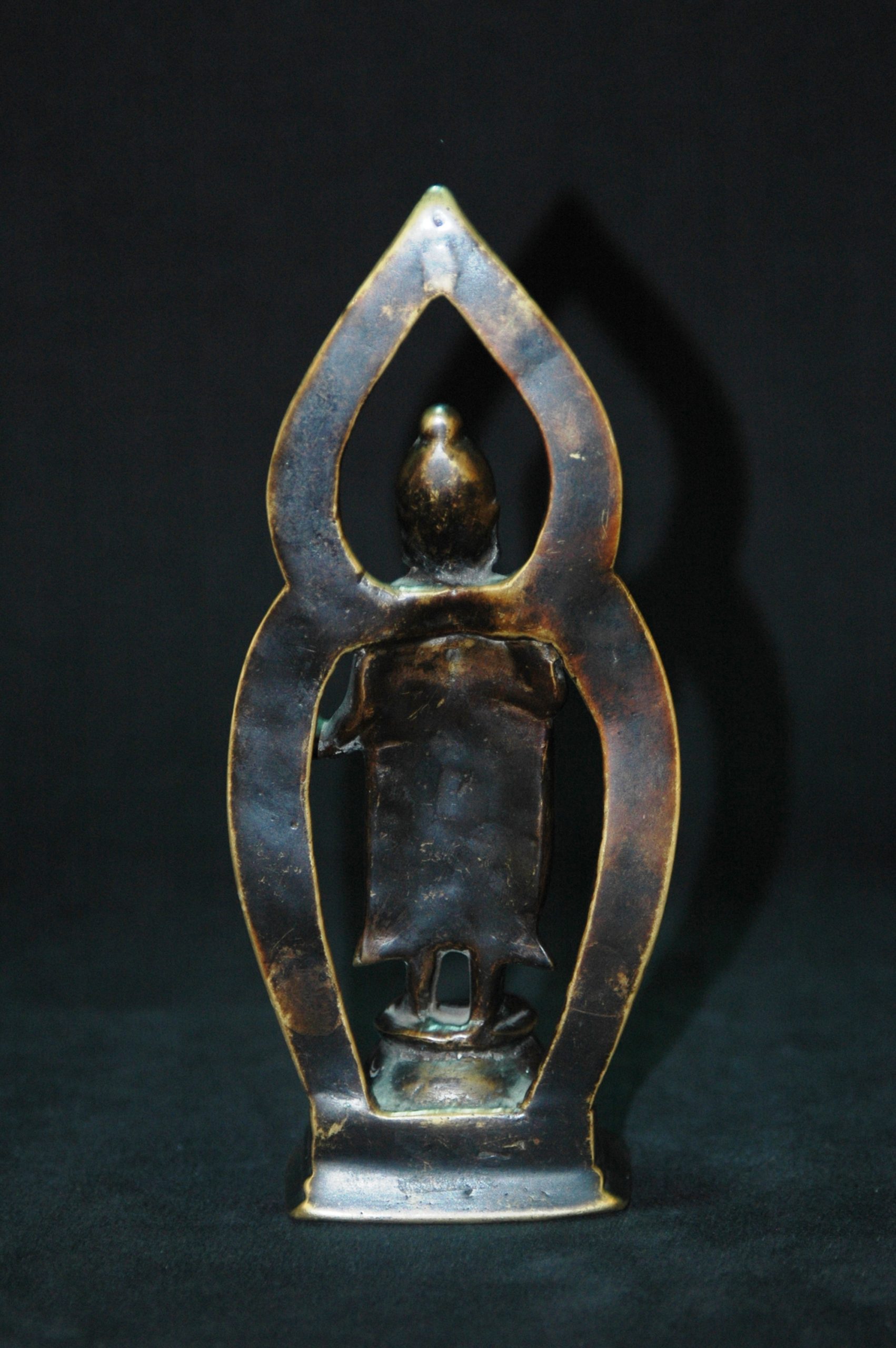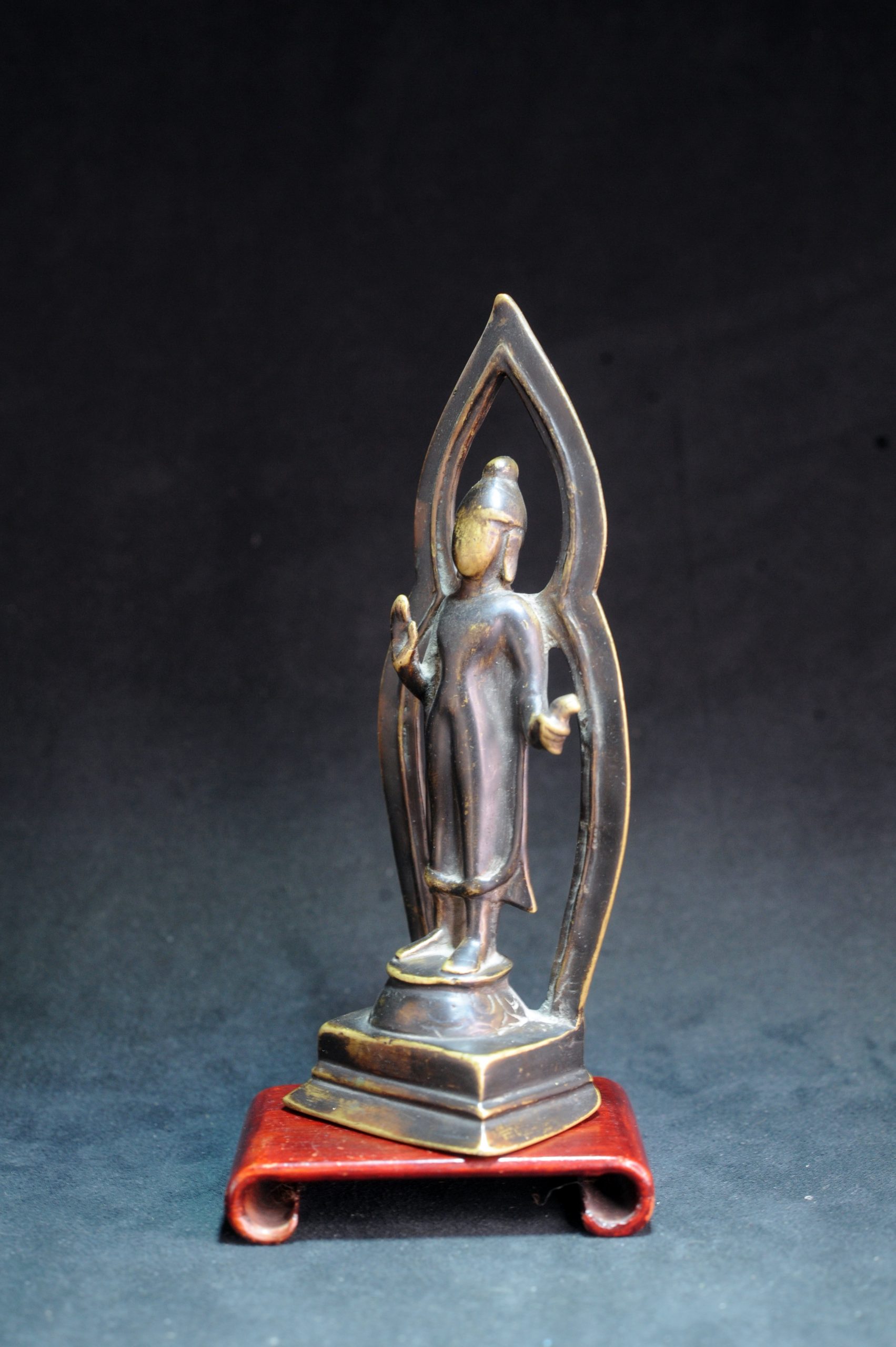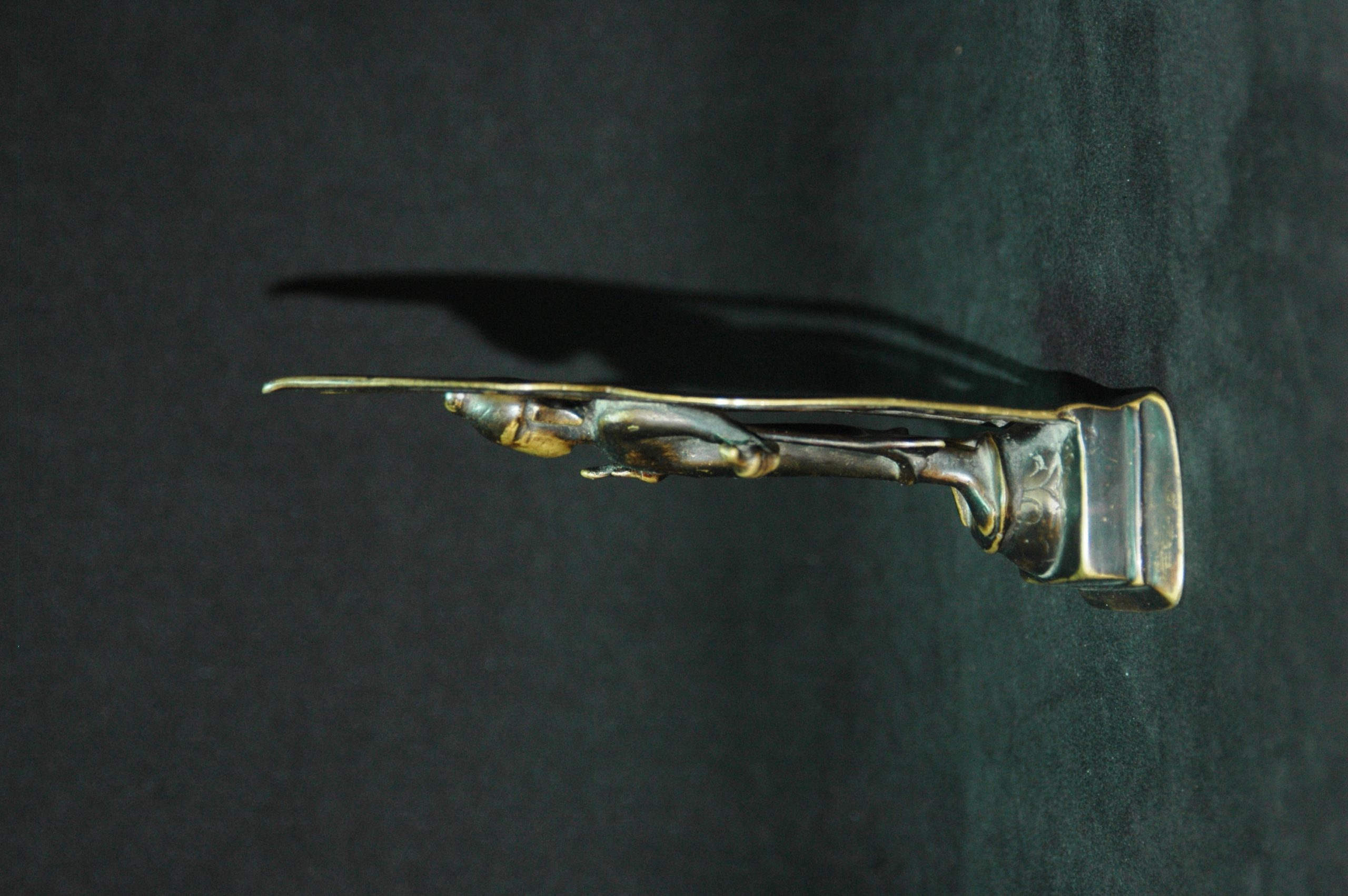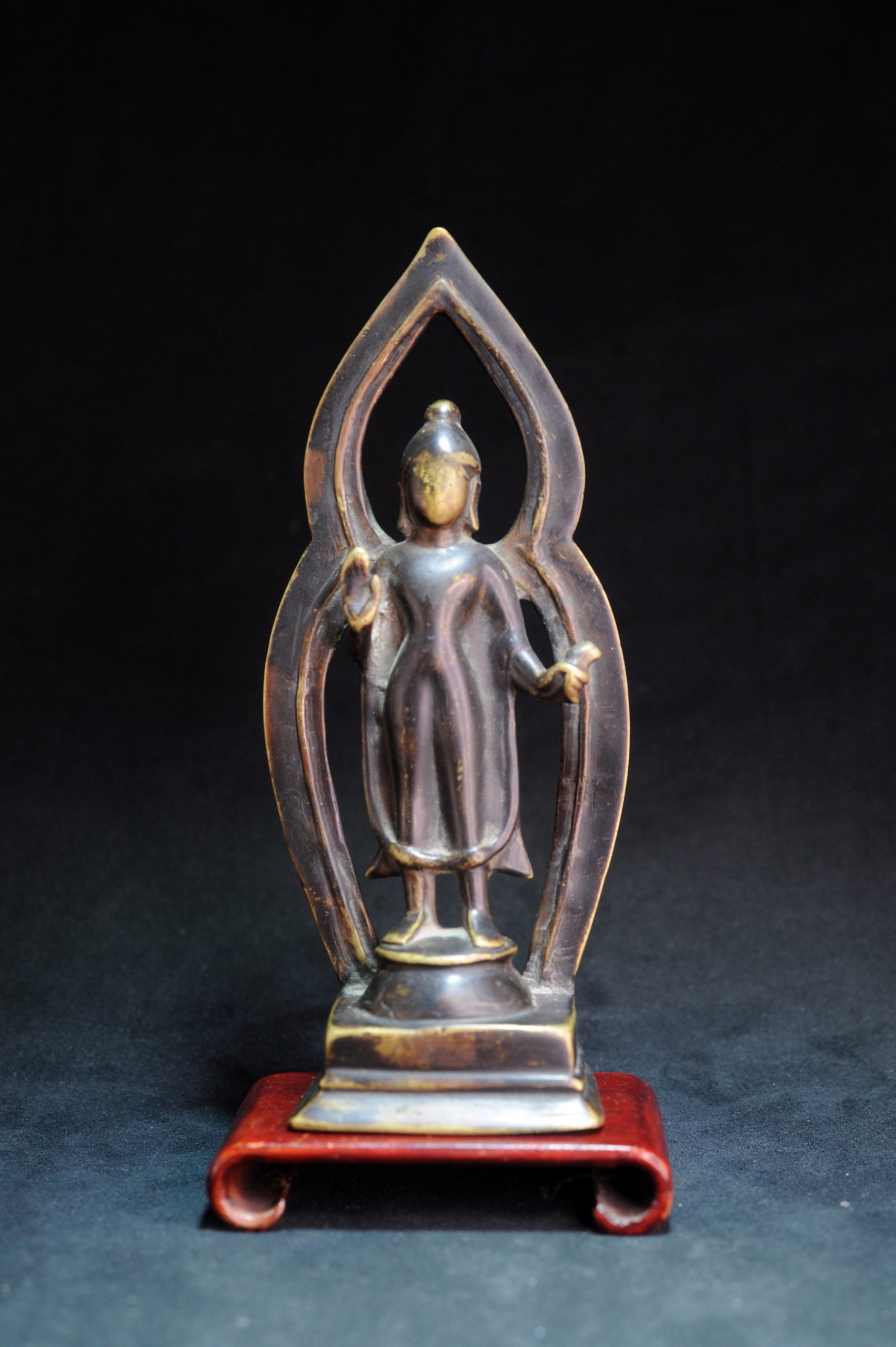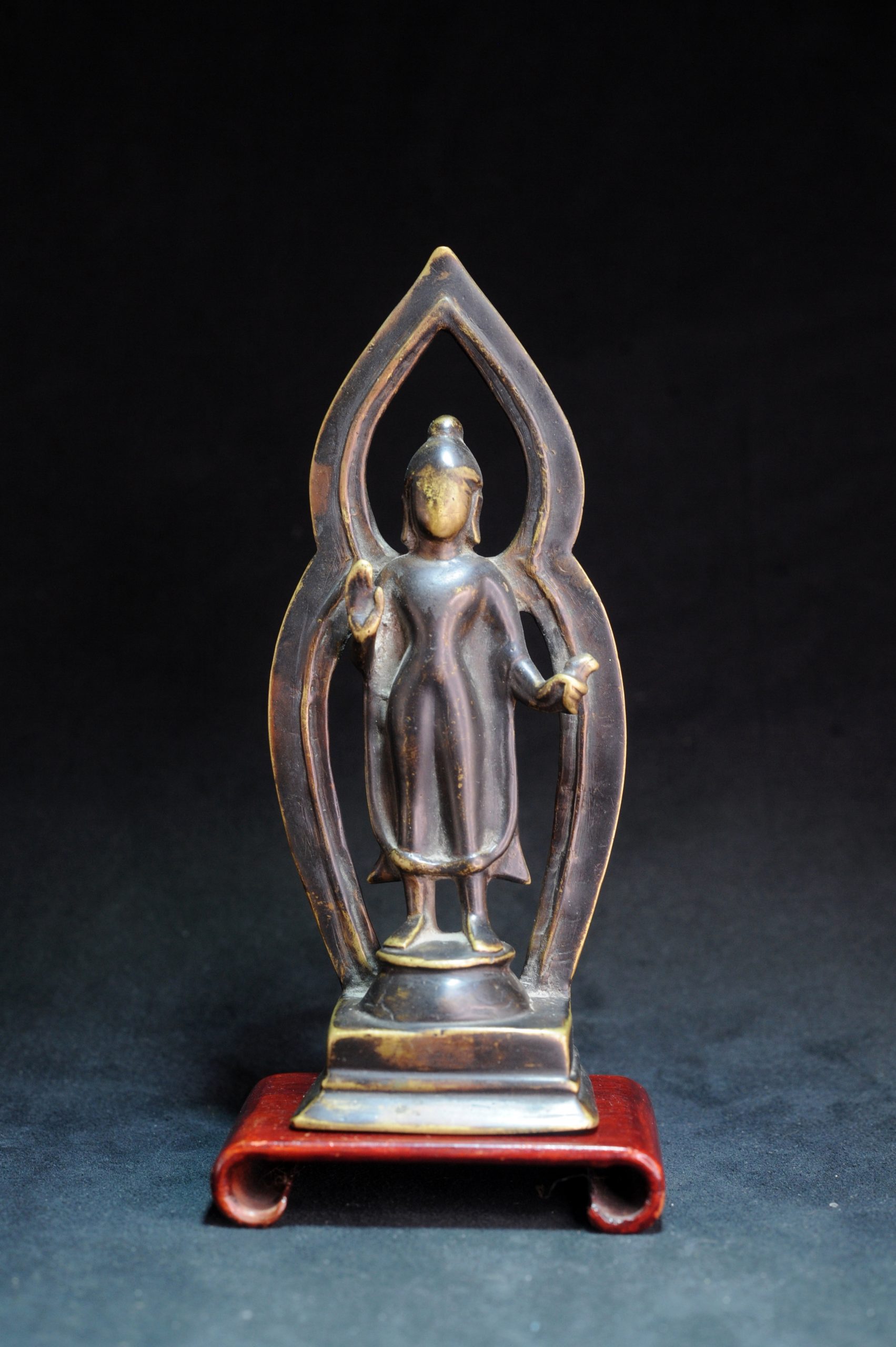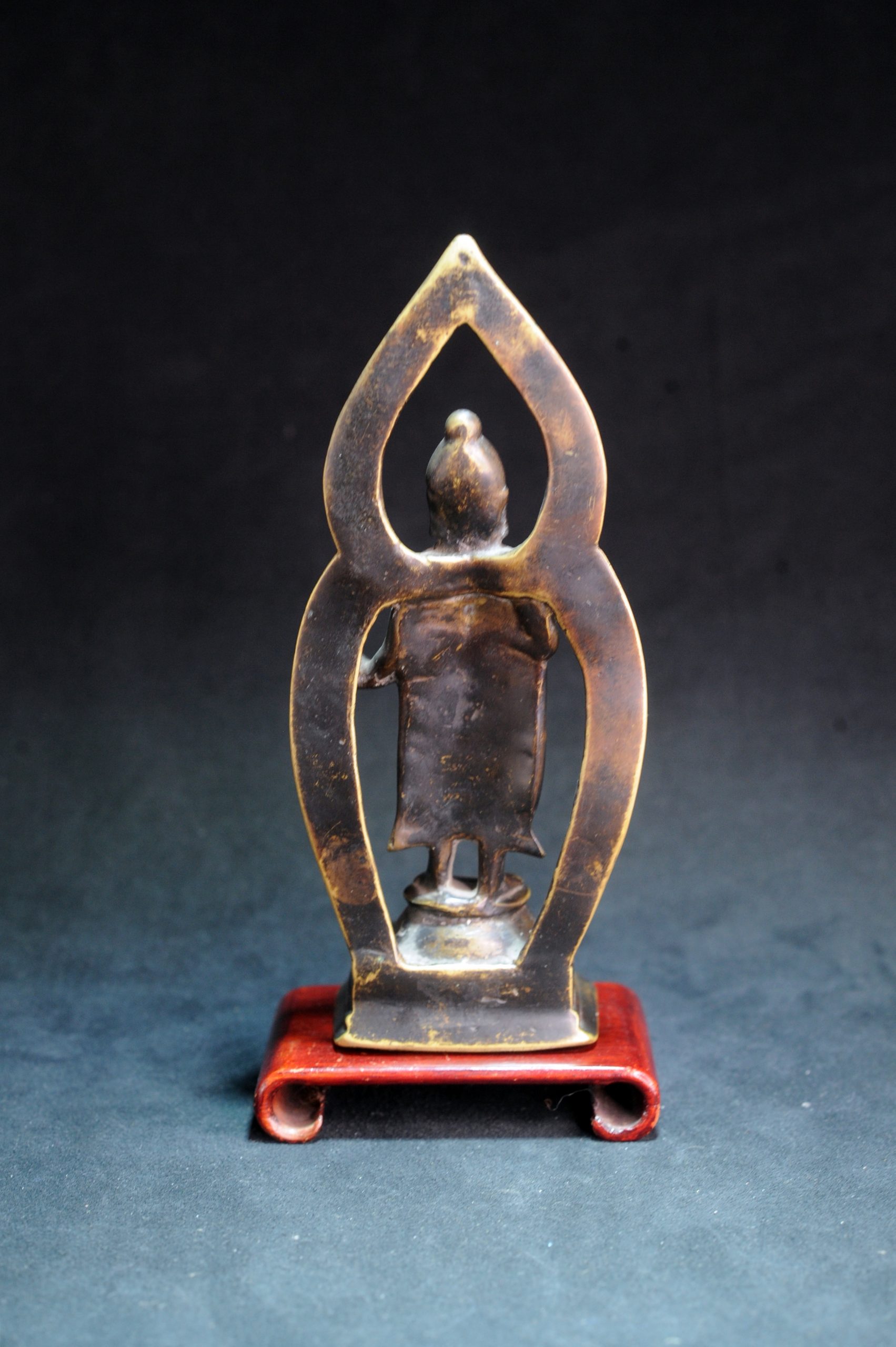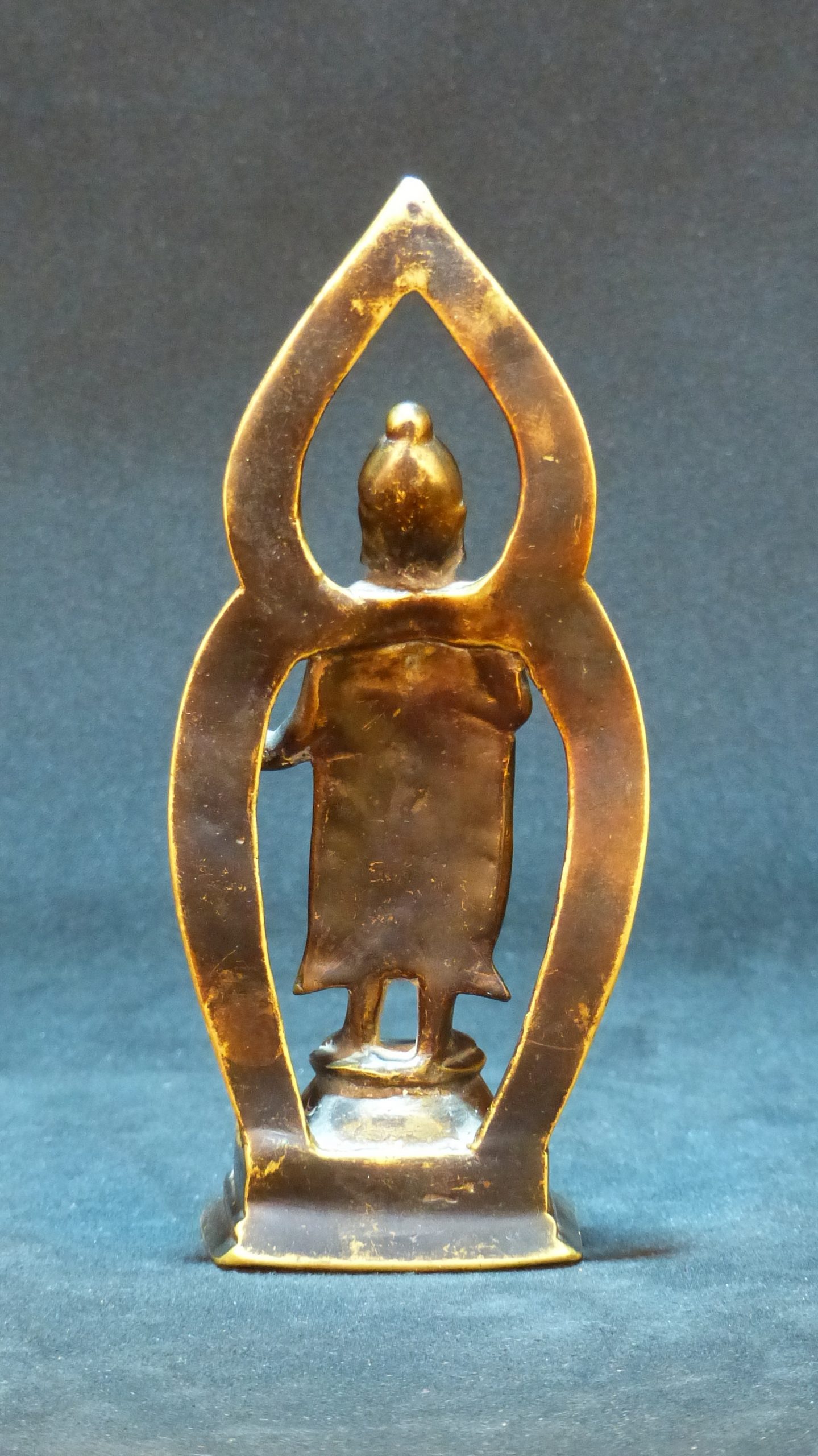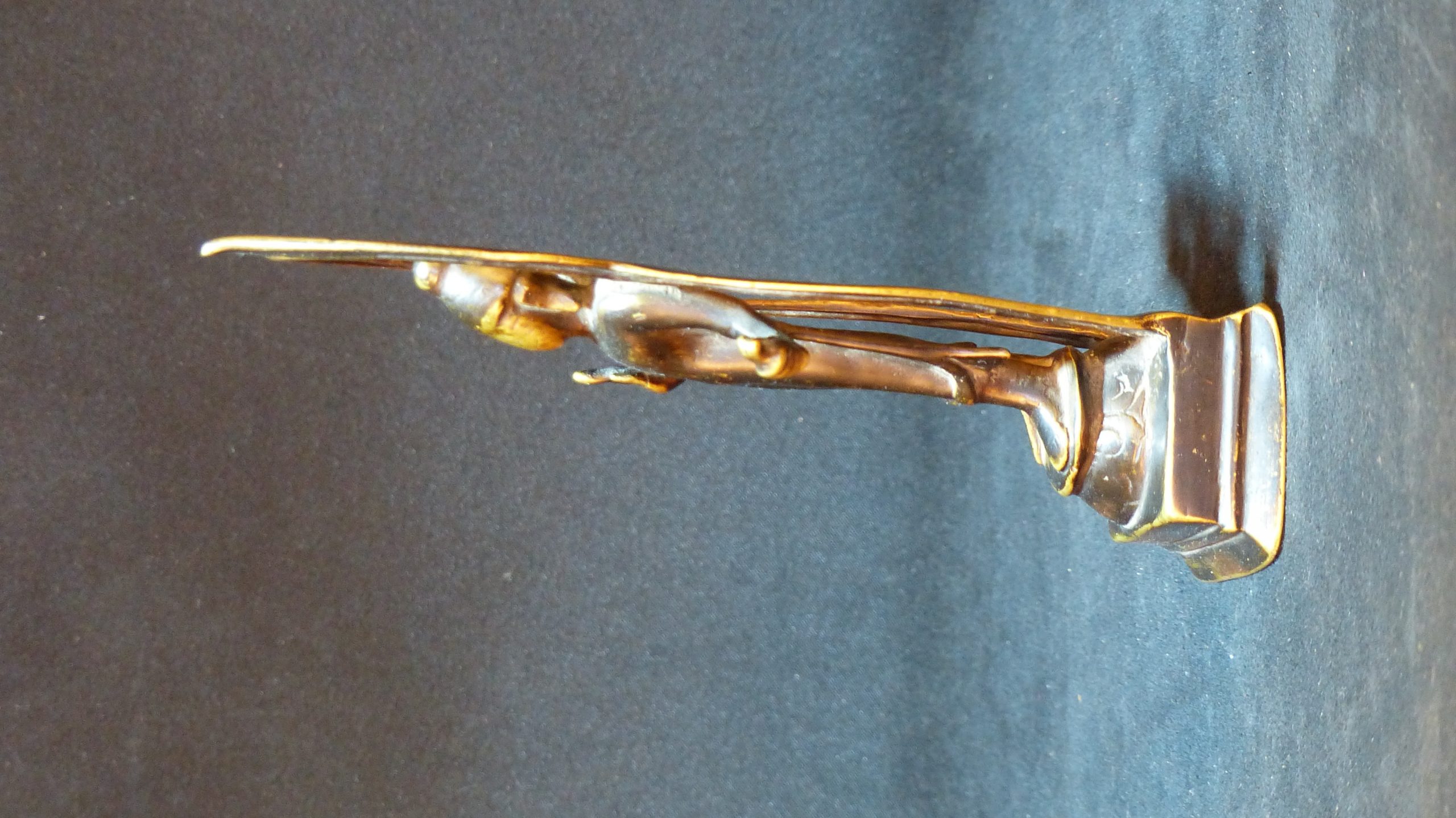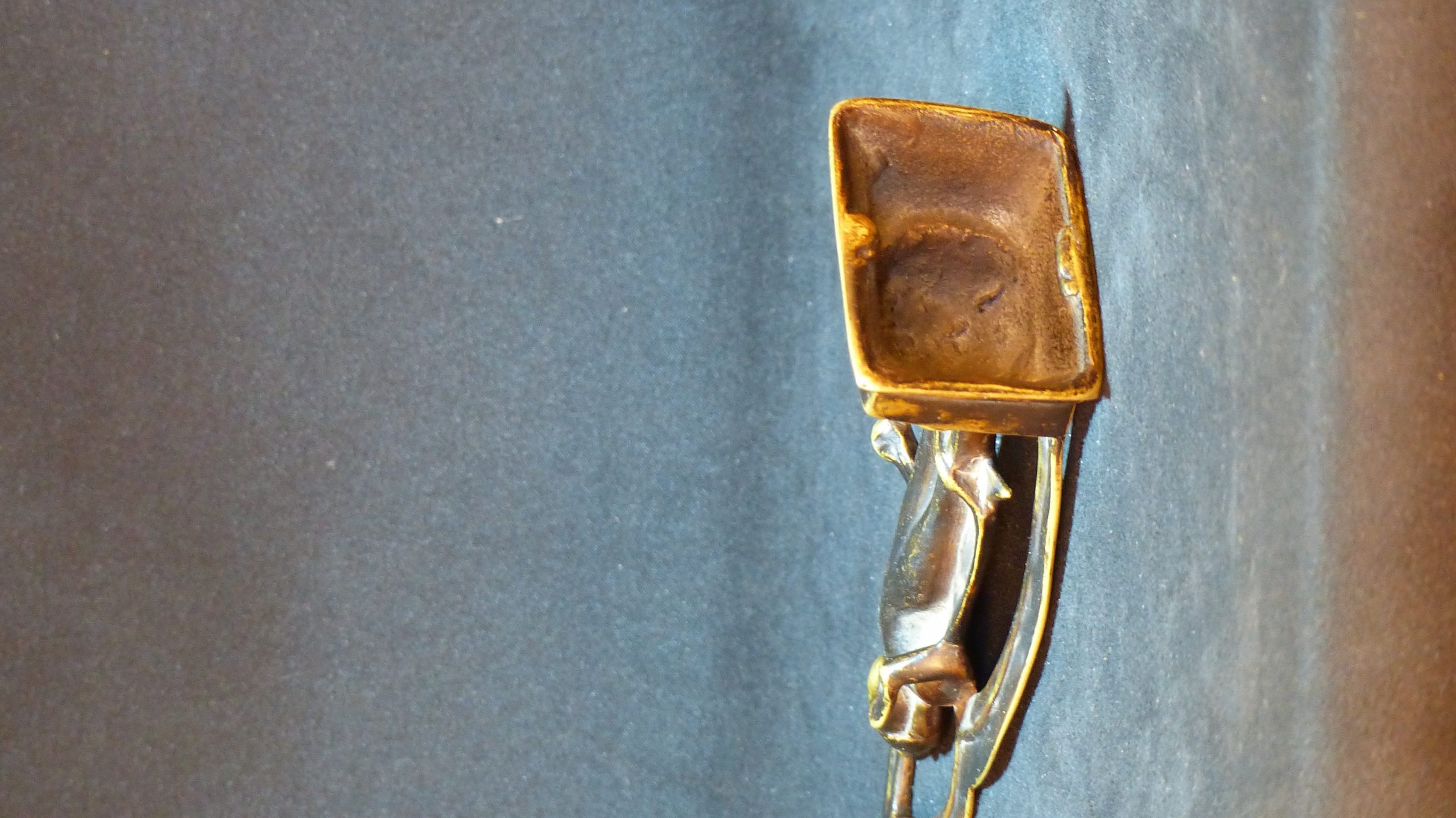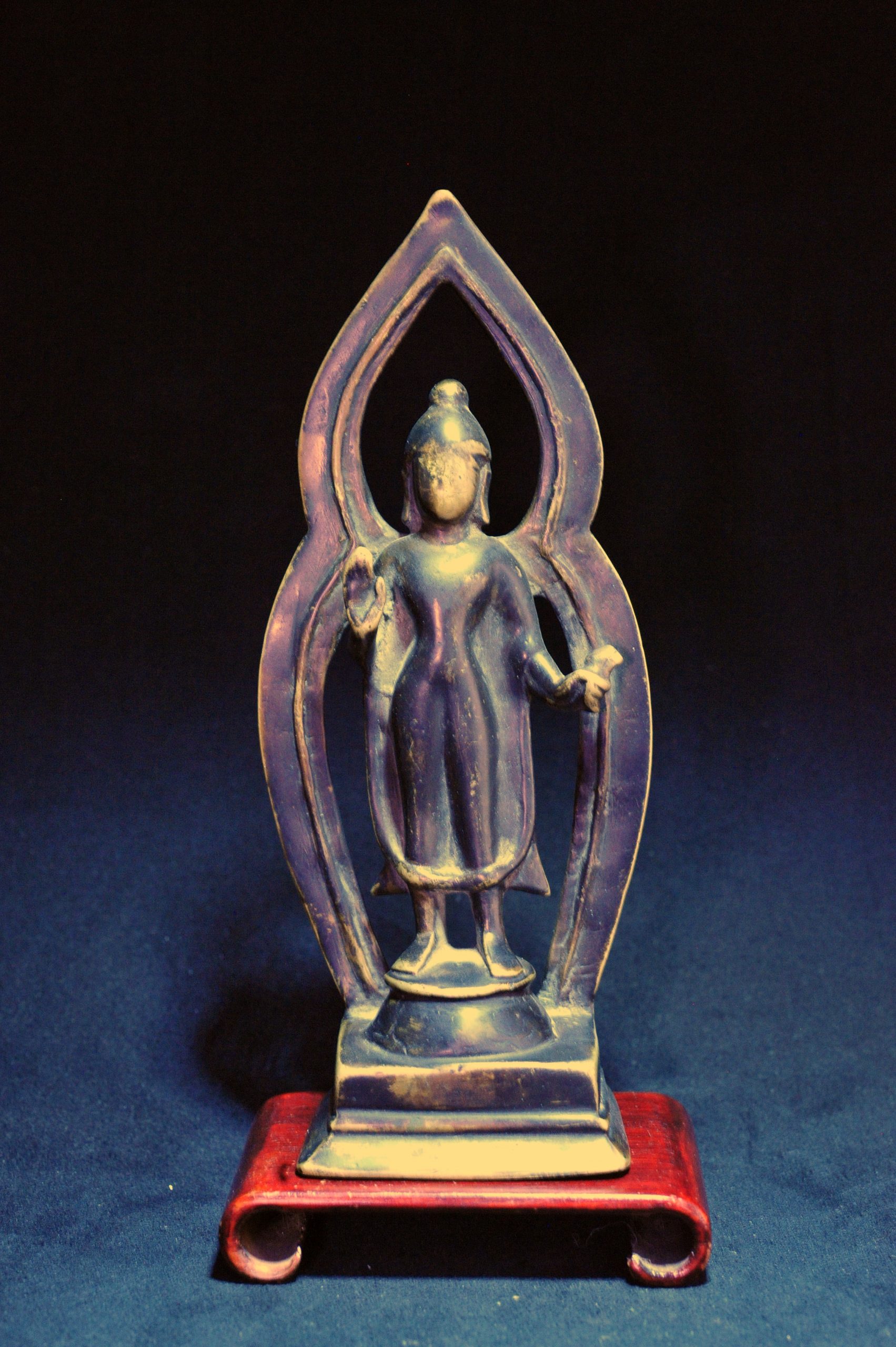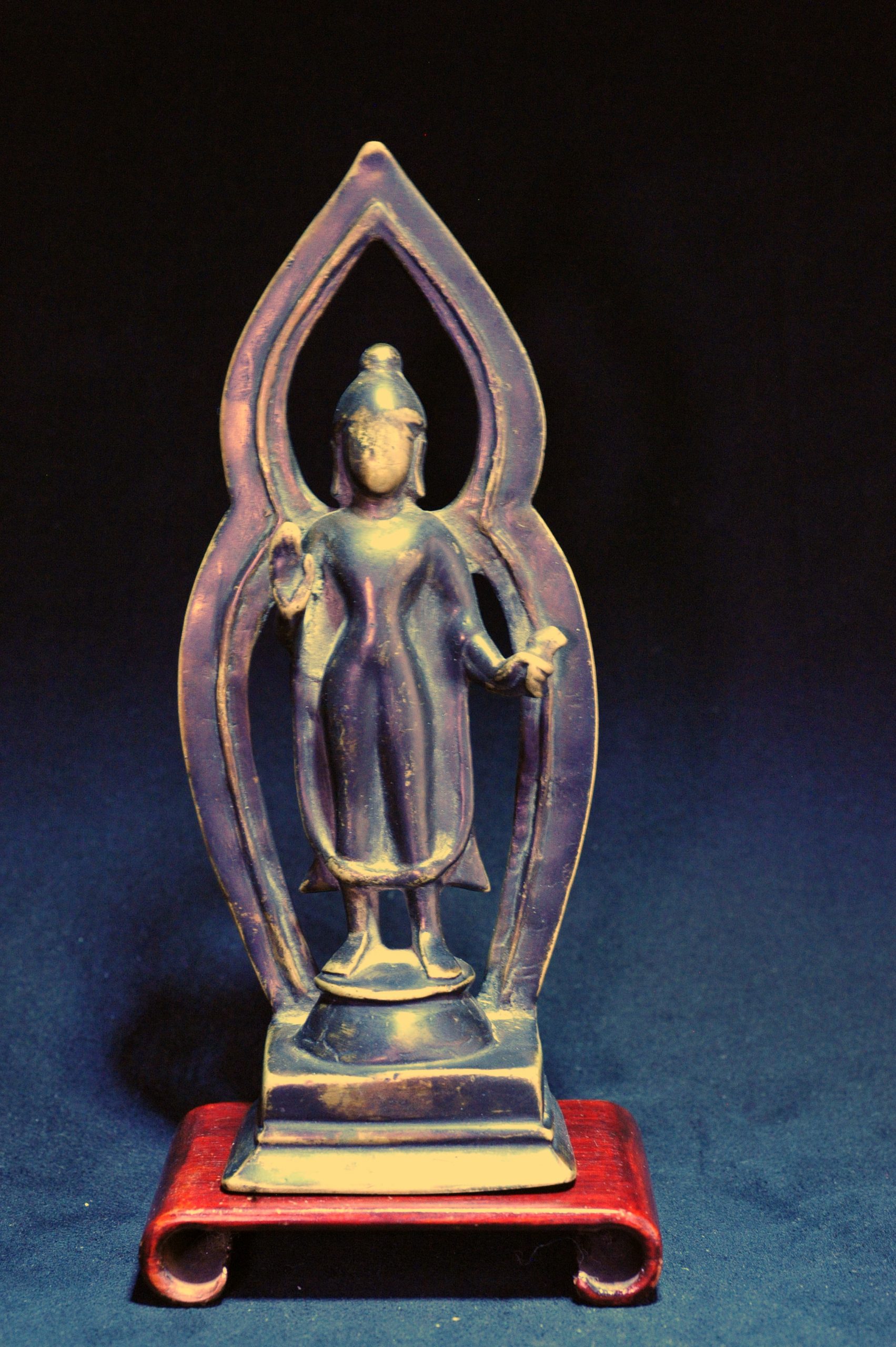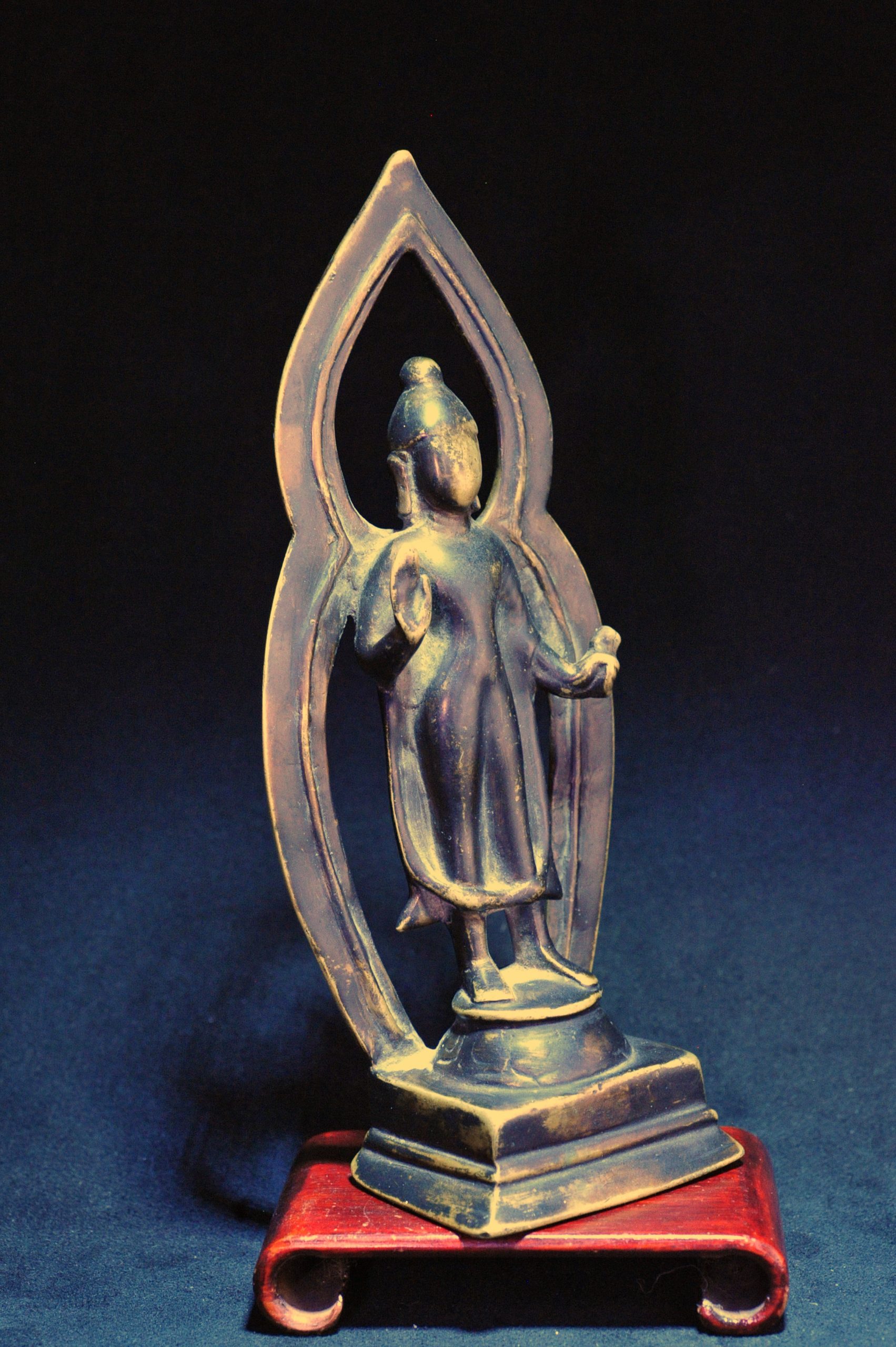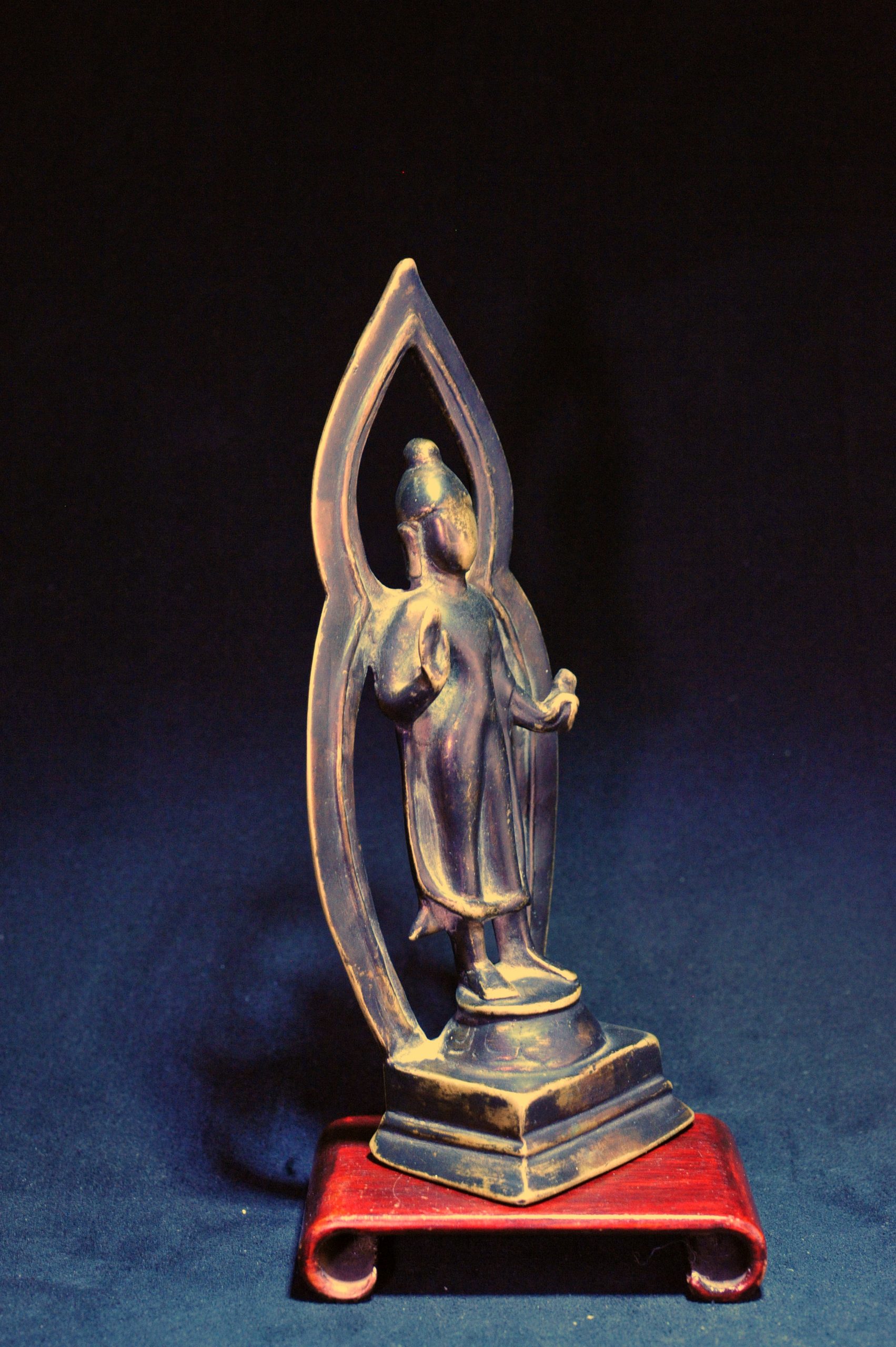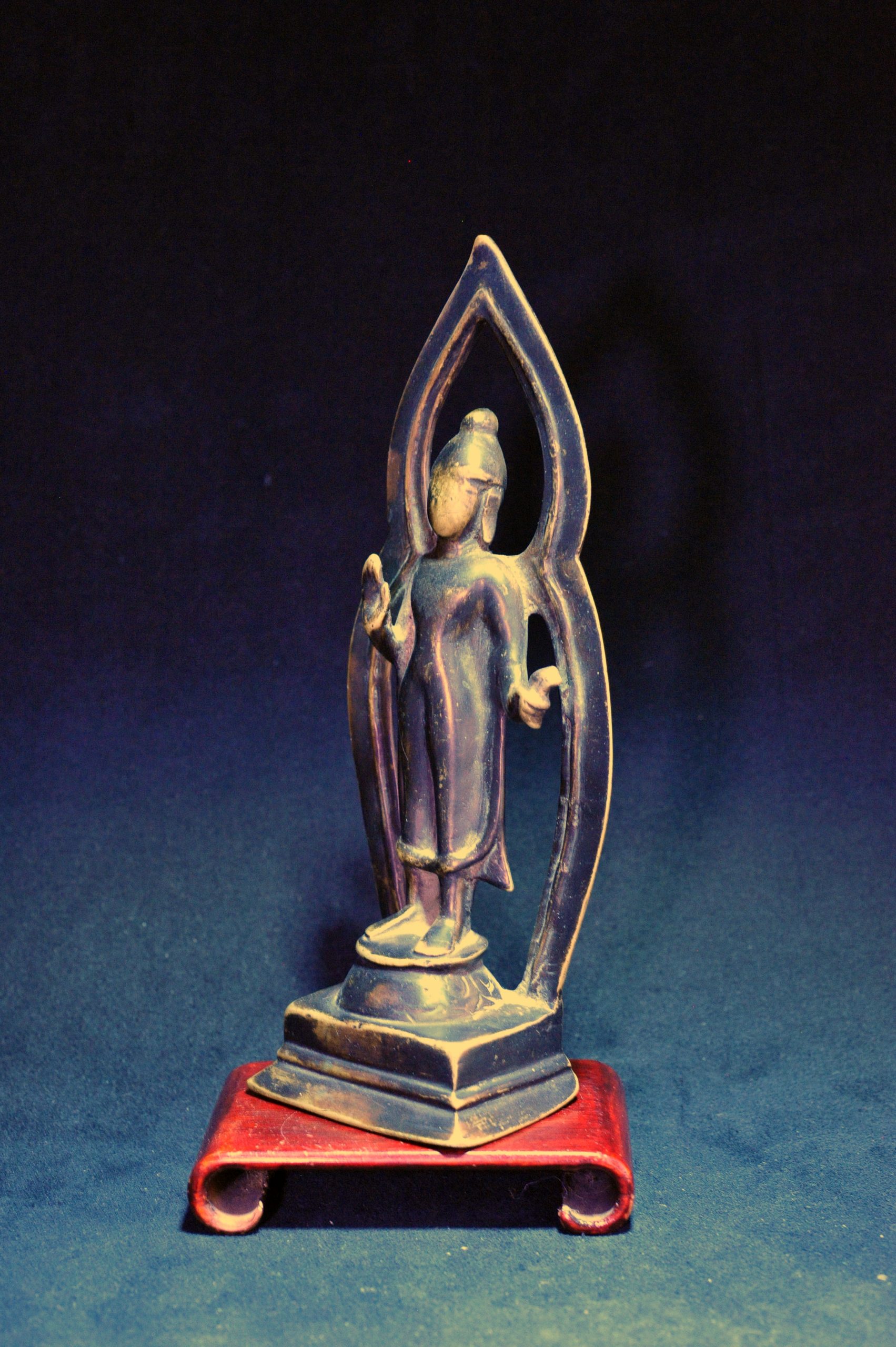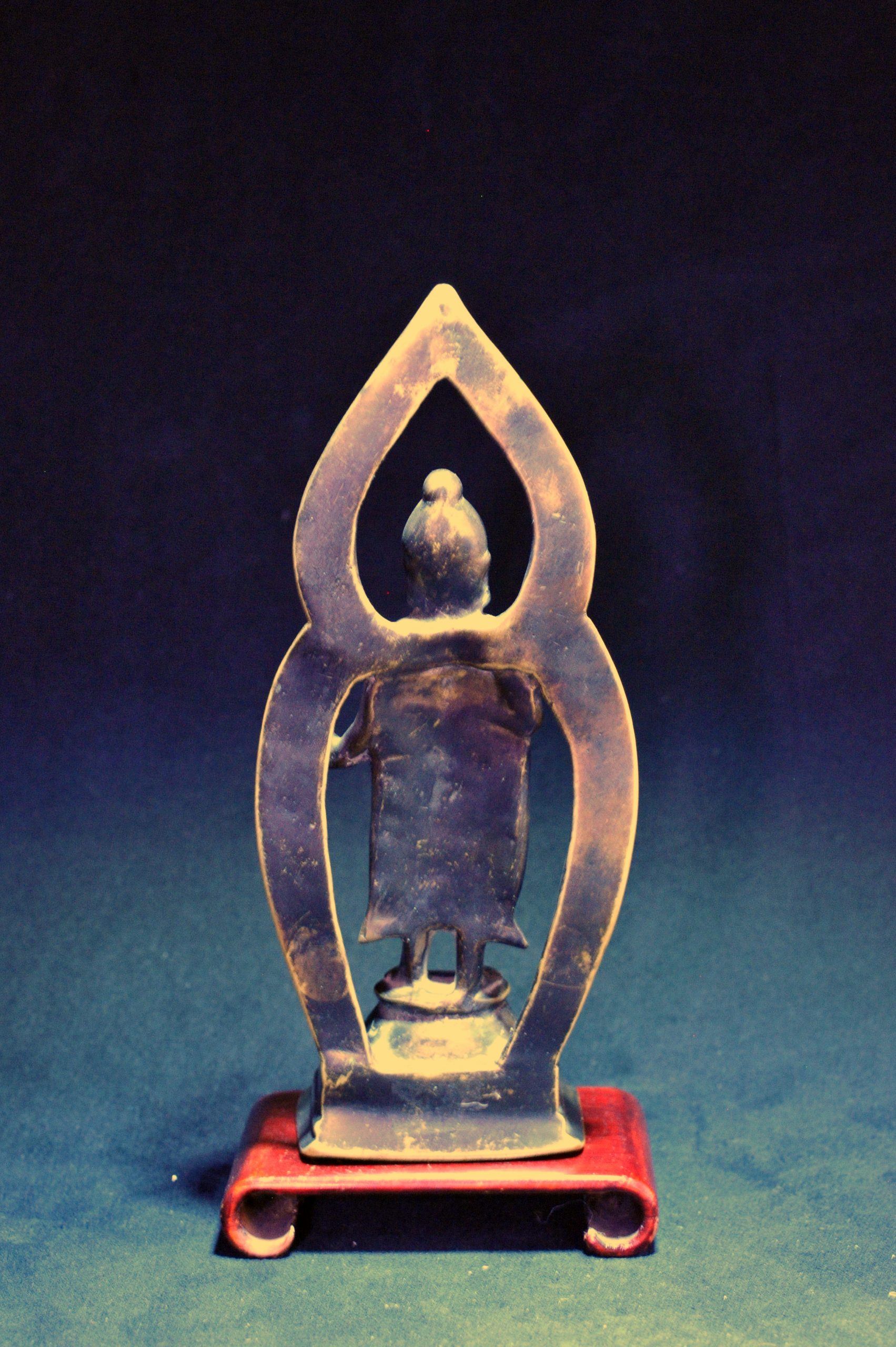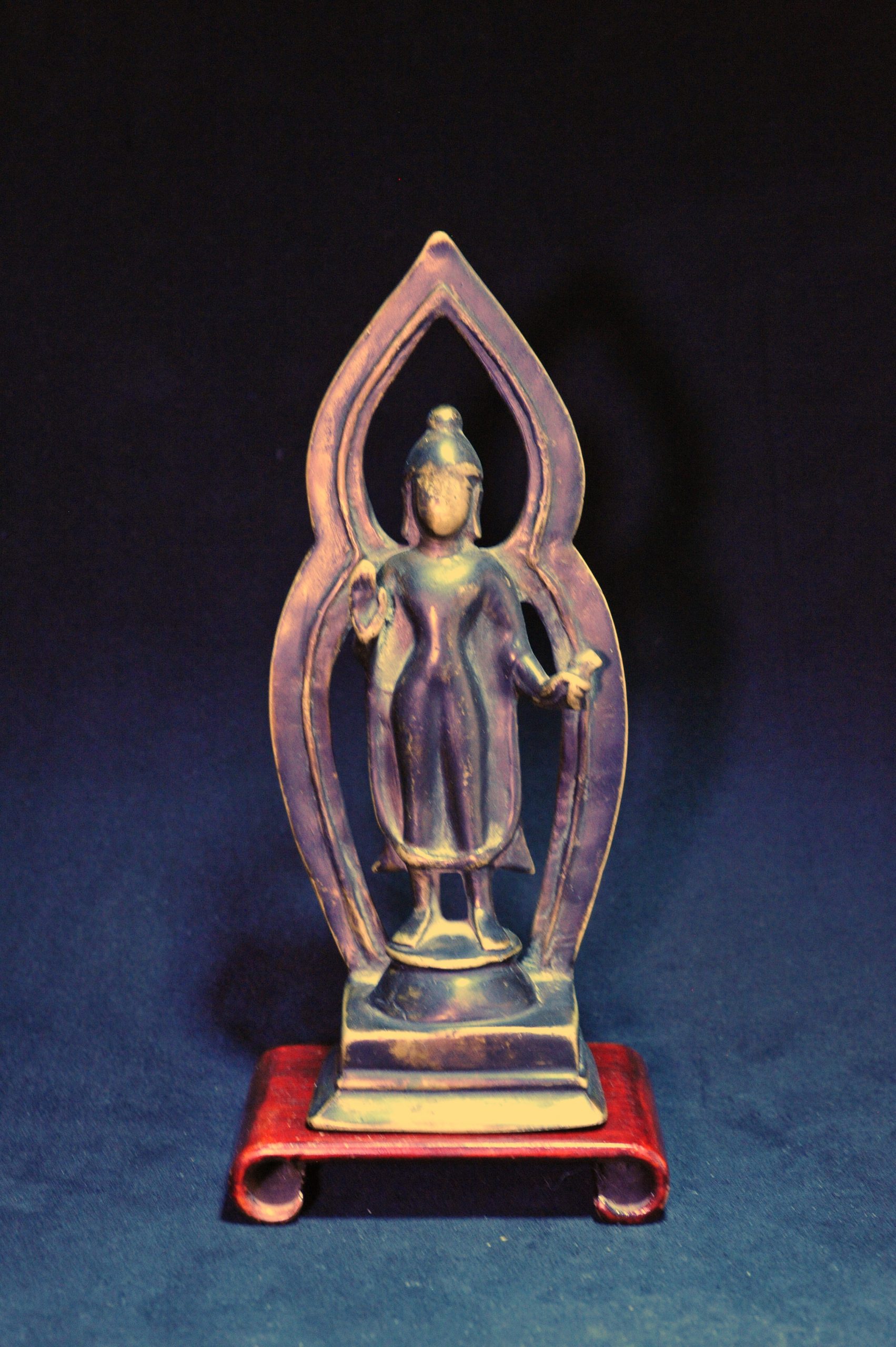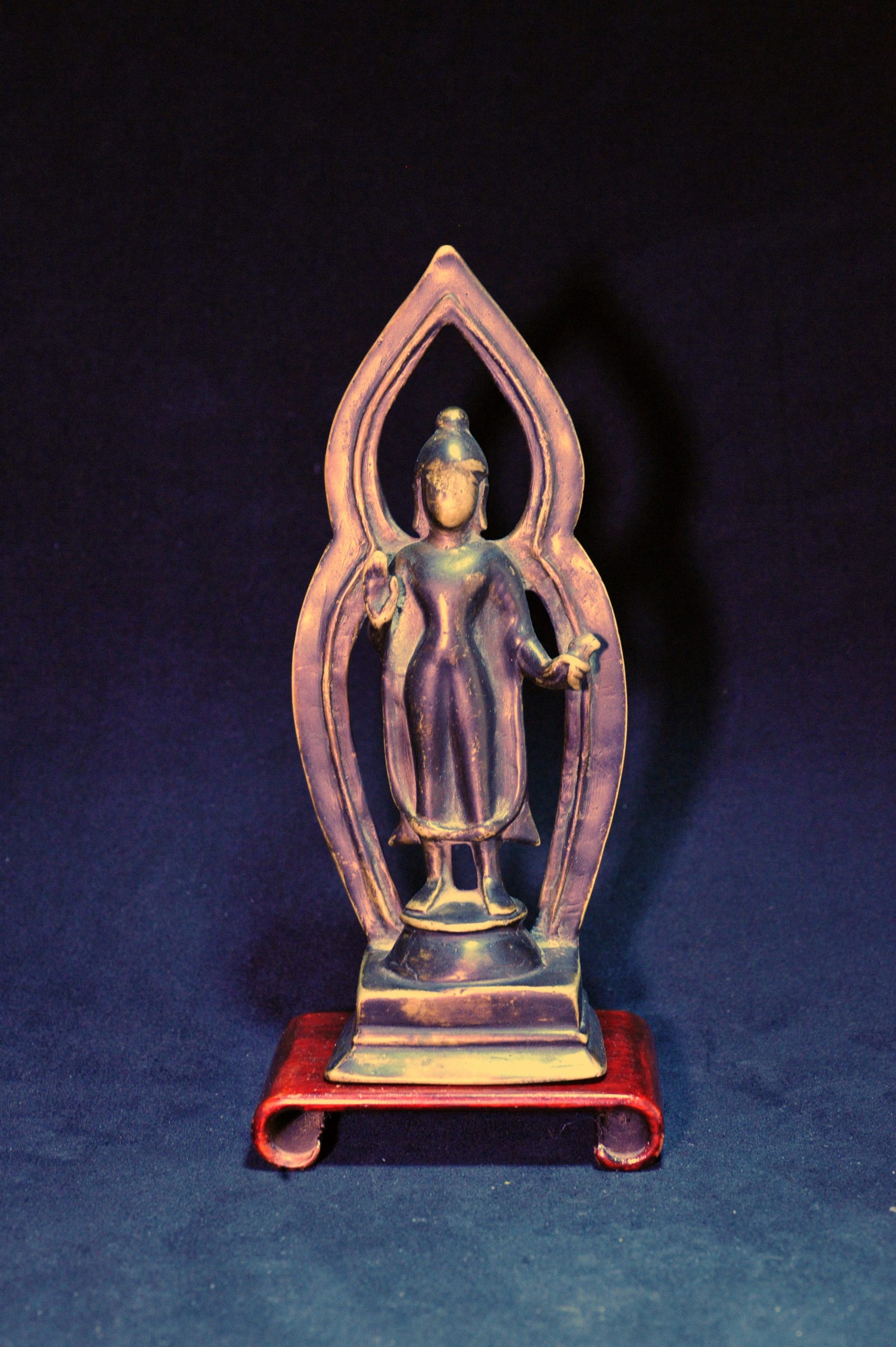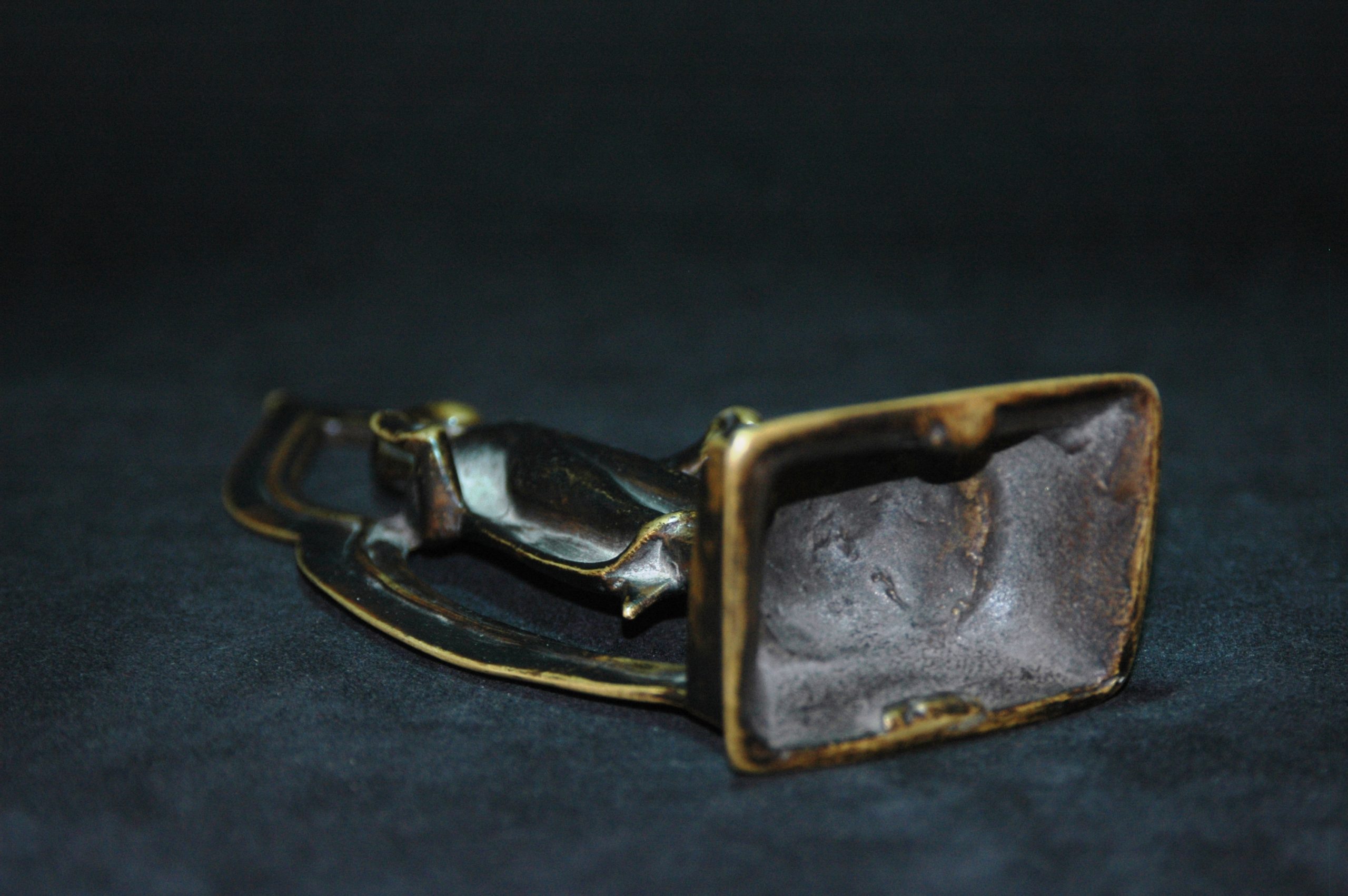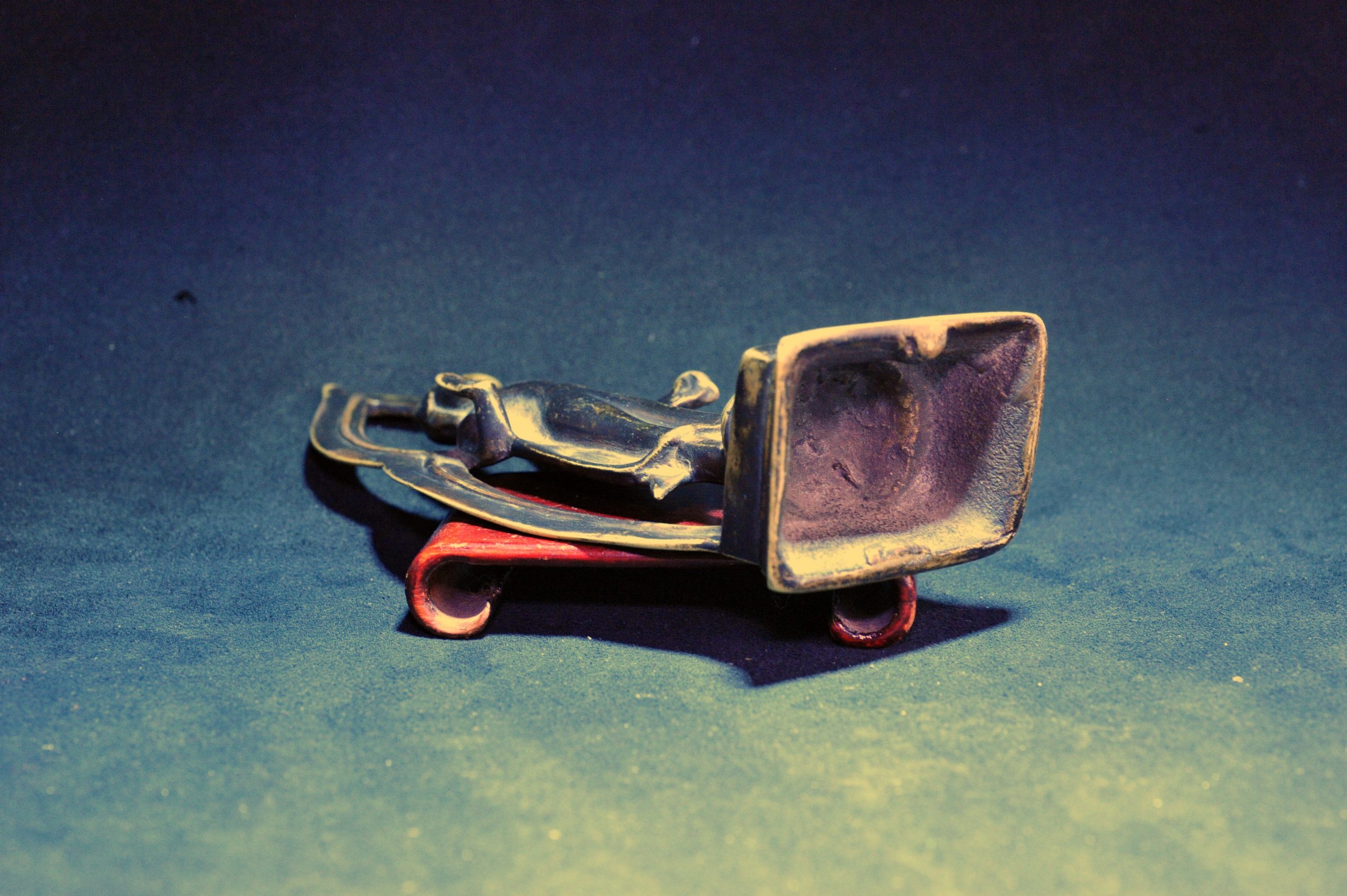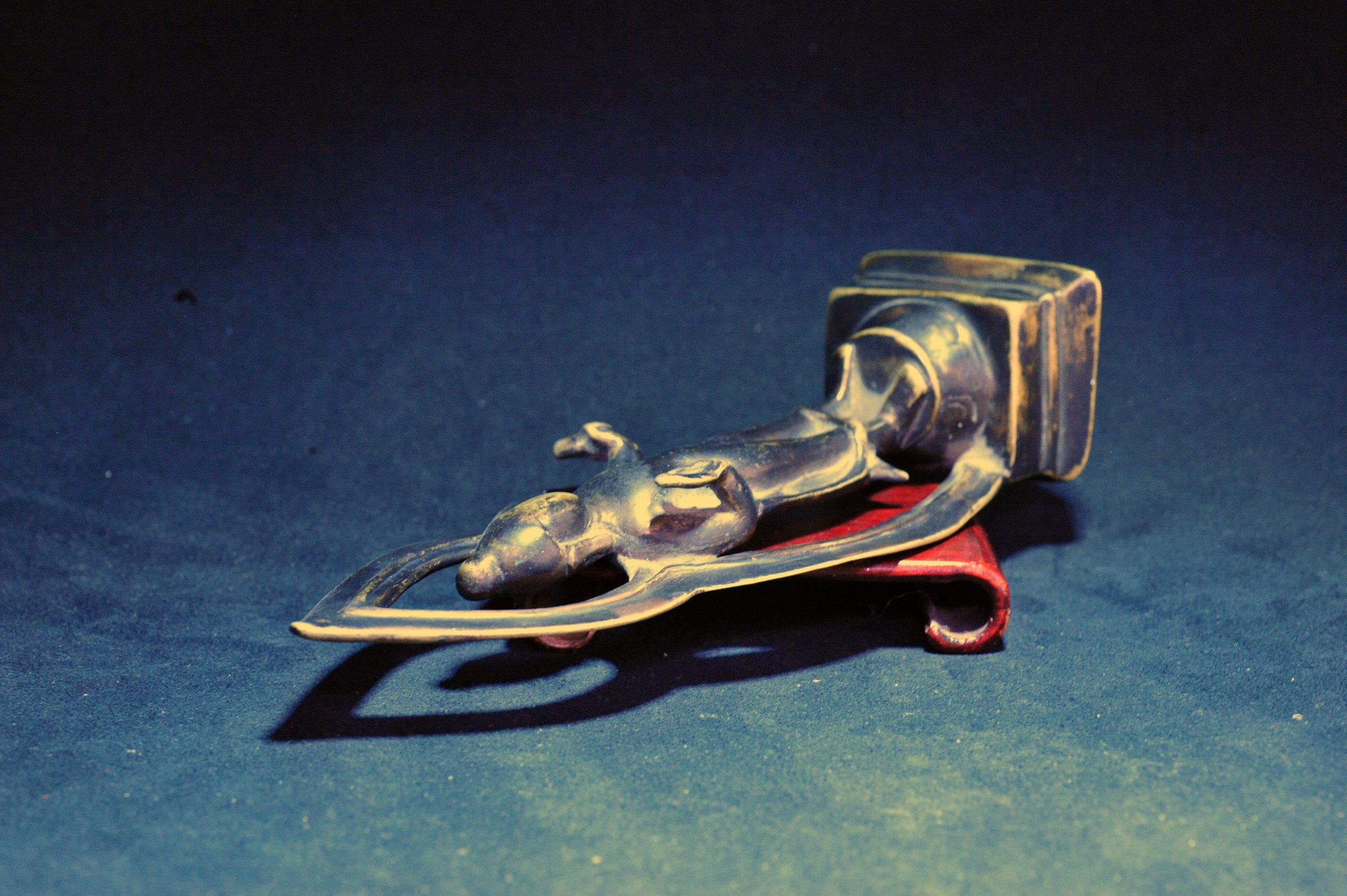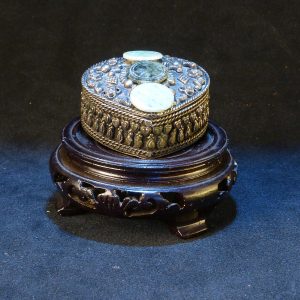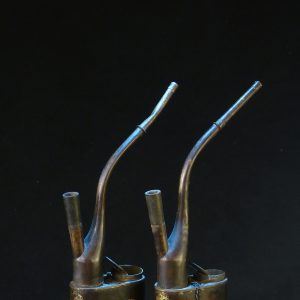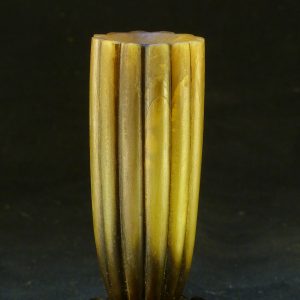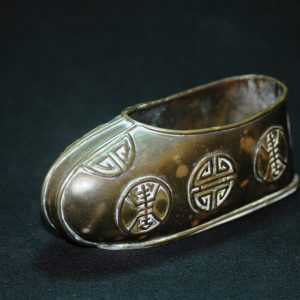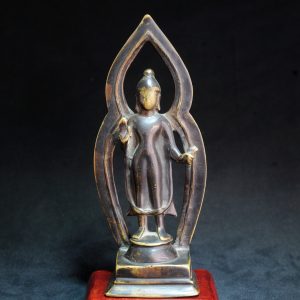Description
10世纪克什米尔佛造像 莲花手释迦牟尼佛立像 立佛
High:7.5in (16CM)
Width:2.5in (6.3CM)
参考:
World Art – Rare Antique Asian,
Islamic & Colonial Decorative Arts
LONDON
5424 印度 那烂陀时期铜佛坐像
Nalanda Cast Bronze Buddha, Nalanda, North-east India,11th-12h century
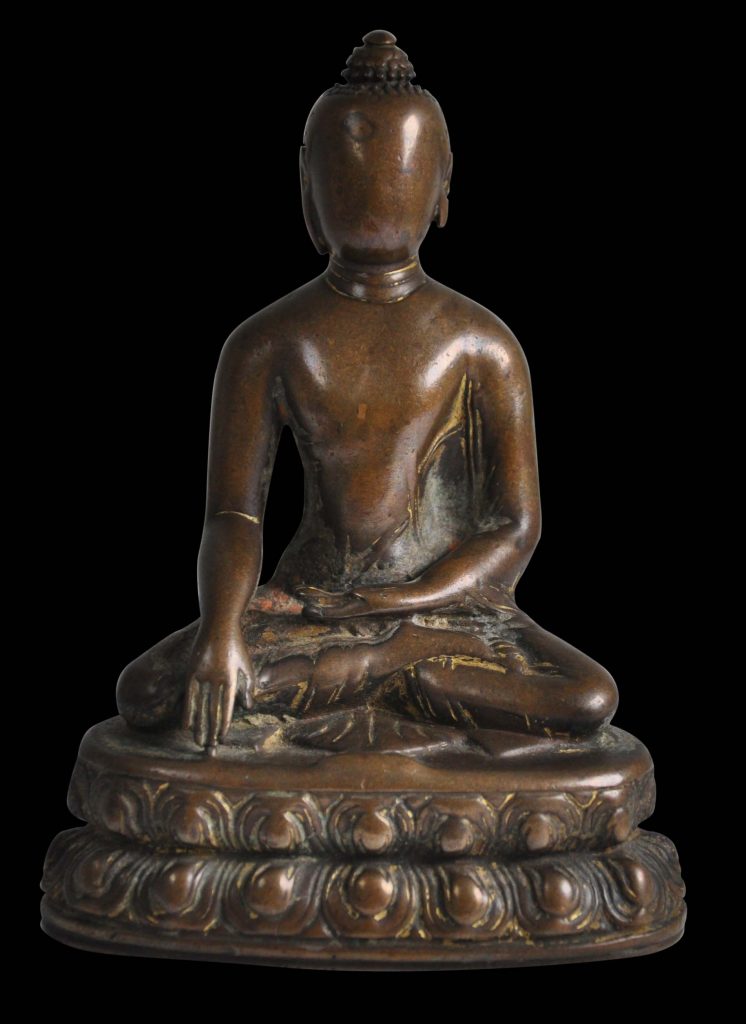
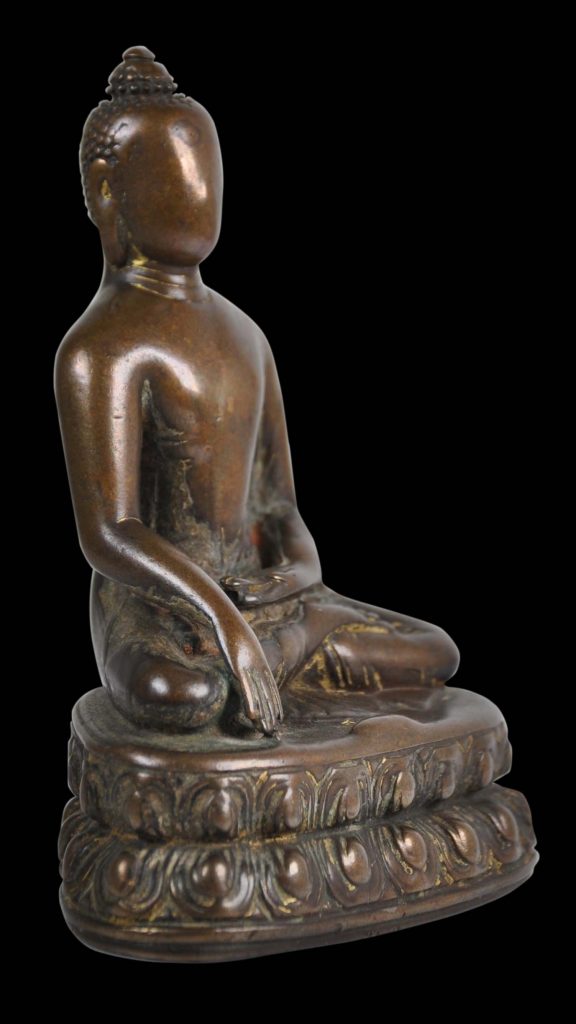
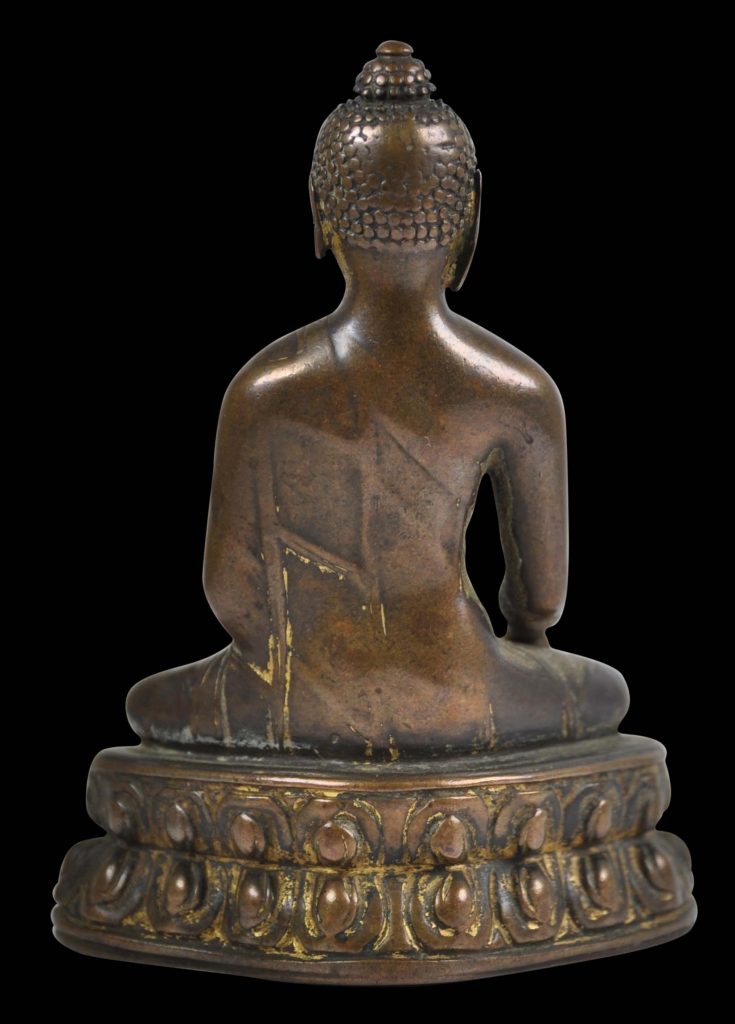
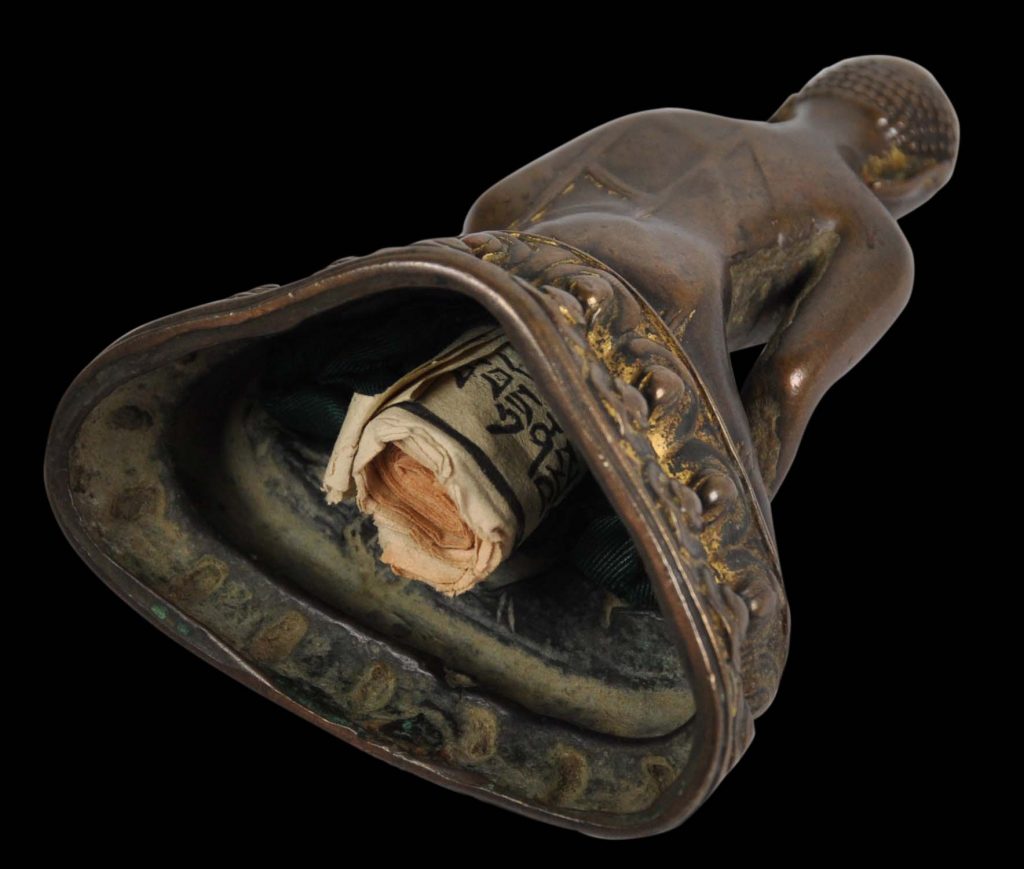
height: 10.6cm, width: 7.8cm
SOLD
PROVENANCE
acquired by the previous owner in London in March 1991.
This cast bronze Buddha image, with traces of gilding, is from Nalanada in northeastern India, and dates to the 12th century.
Nalanda was an ancient Mahavihara, or a large and important Buddhist monastery, in the ancient kingdom of Magadha (modern-day Bihar). It was an important centre of learning from the 5th to the 12th centuries, when it was destroyed by Muslim invaders.
The image is unusual because its face has been rubbed and caressed to the point where its features have been worn completely smooth. Such wear is not typical of Tibetan prayer usage (for example) or indeed even of Buddhist ritual wear. What it is typical of, however, is Hindu ritual wear. But this is consistent with the piece coming from the earlier stages of Buddhism (which grew out of Hinduism) in India.
The wear suggests it has been ritually lustrated, cleaned and rubbed, wearing away its features over many years.
The image itself show the Buddha seated in padmasana on a double-lotus throne, with hands in the bhumispara mudra (‘calling the earth to witness’) position.
The base is open and a rolled Tibetan prayer scroll has been inserted into the cavity but this is likely to be a recent addition.
Overall, this is a rare, unusual and early piece.
REFERENCES
Pal. P., The Art of Tibet, The Asia Society, 1969.
参考:佳士得 2020 | Live Auction 19039
Sacred and Imperial: The James and Marilynn Alsdorf Collection Part II
Lot 939
A GILT-COPPER FIGURE OF SADASHIVA
NEPAL, LICCHAVI PERIOD, 9TH CENTURY OR LATER
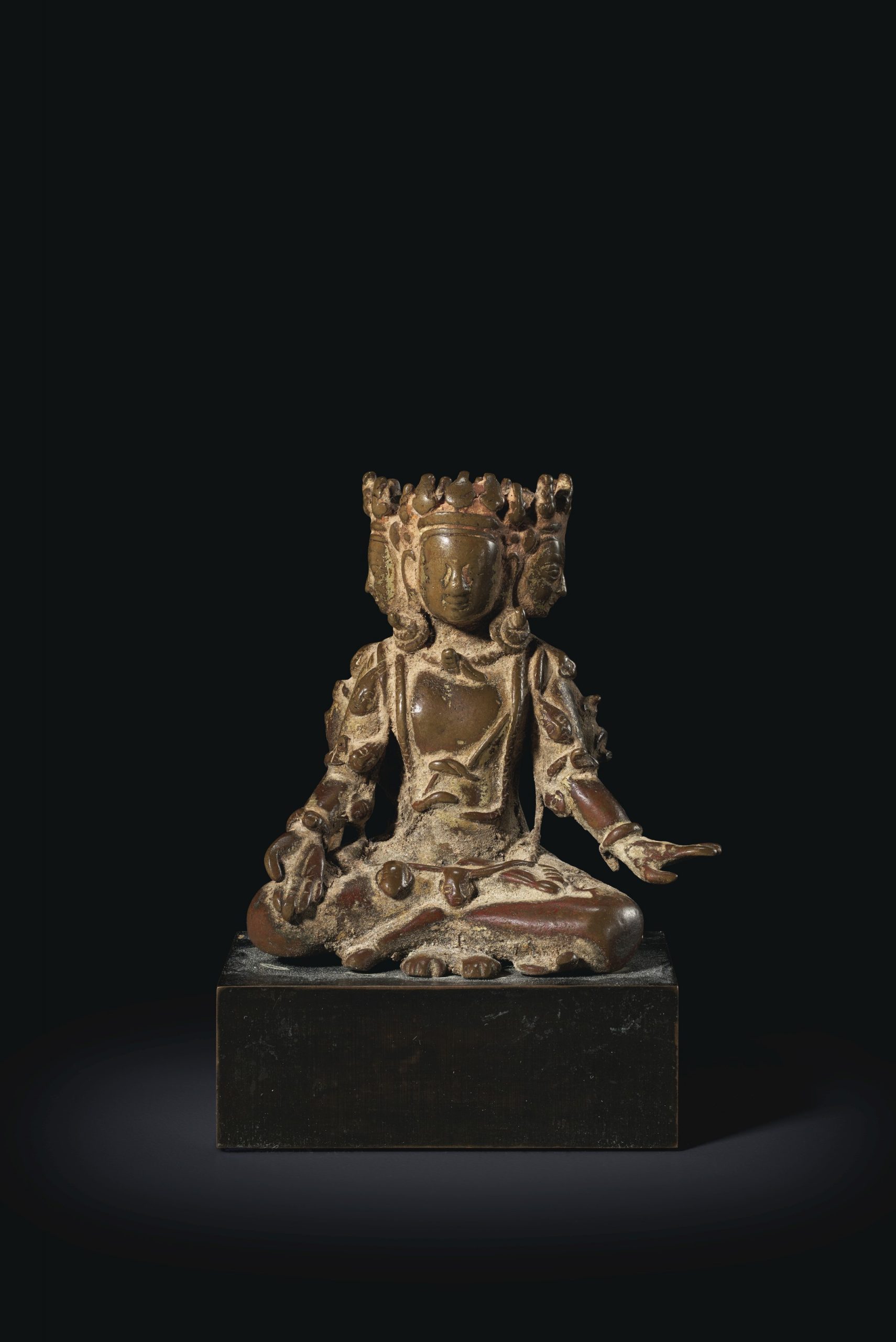
NEPAL, LICCHAVI PERIOD, 9TH CENTURY OR LATER
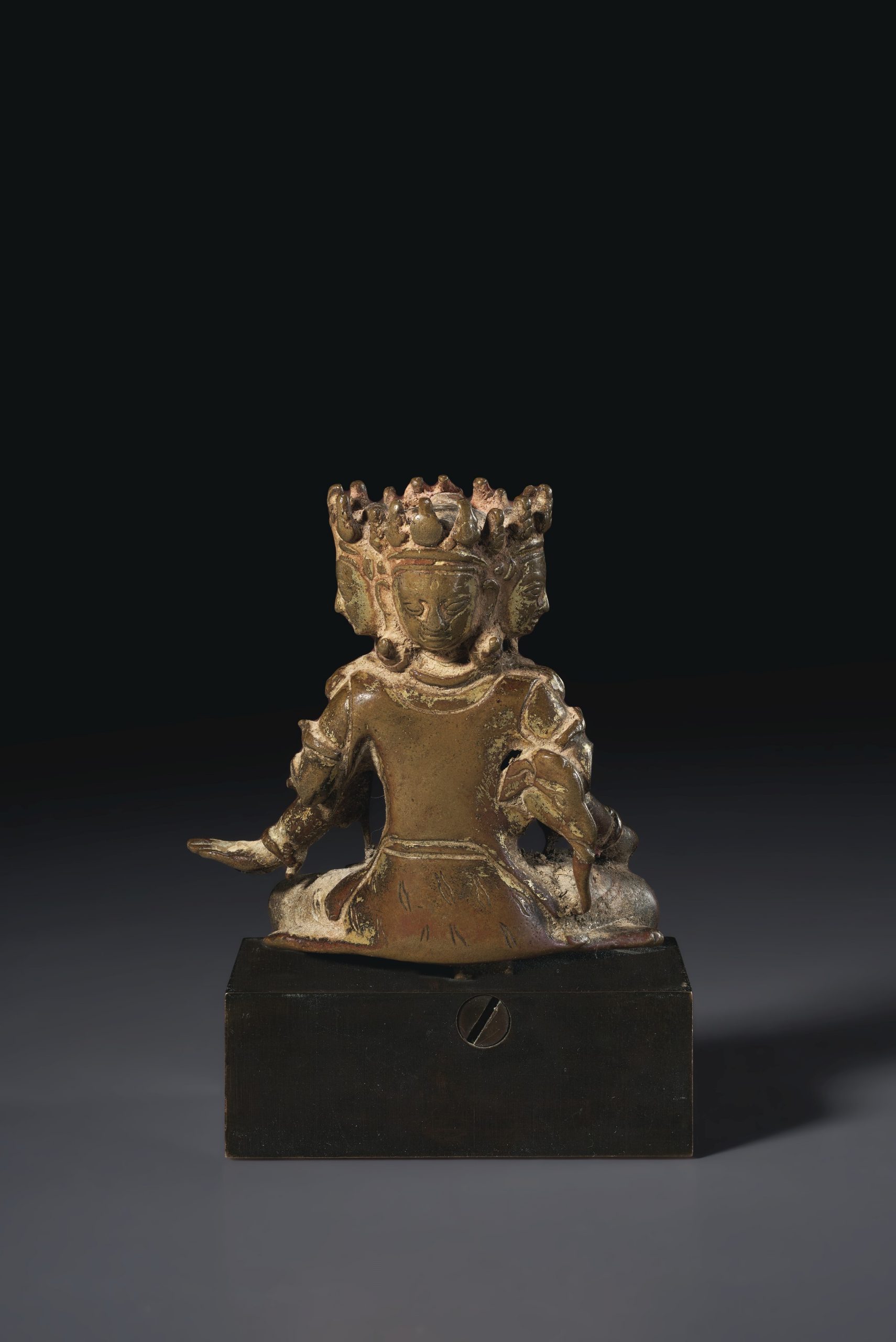
NEPAL, LICCHAVI PERIOD, 9TH CENTURY OR LATER
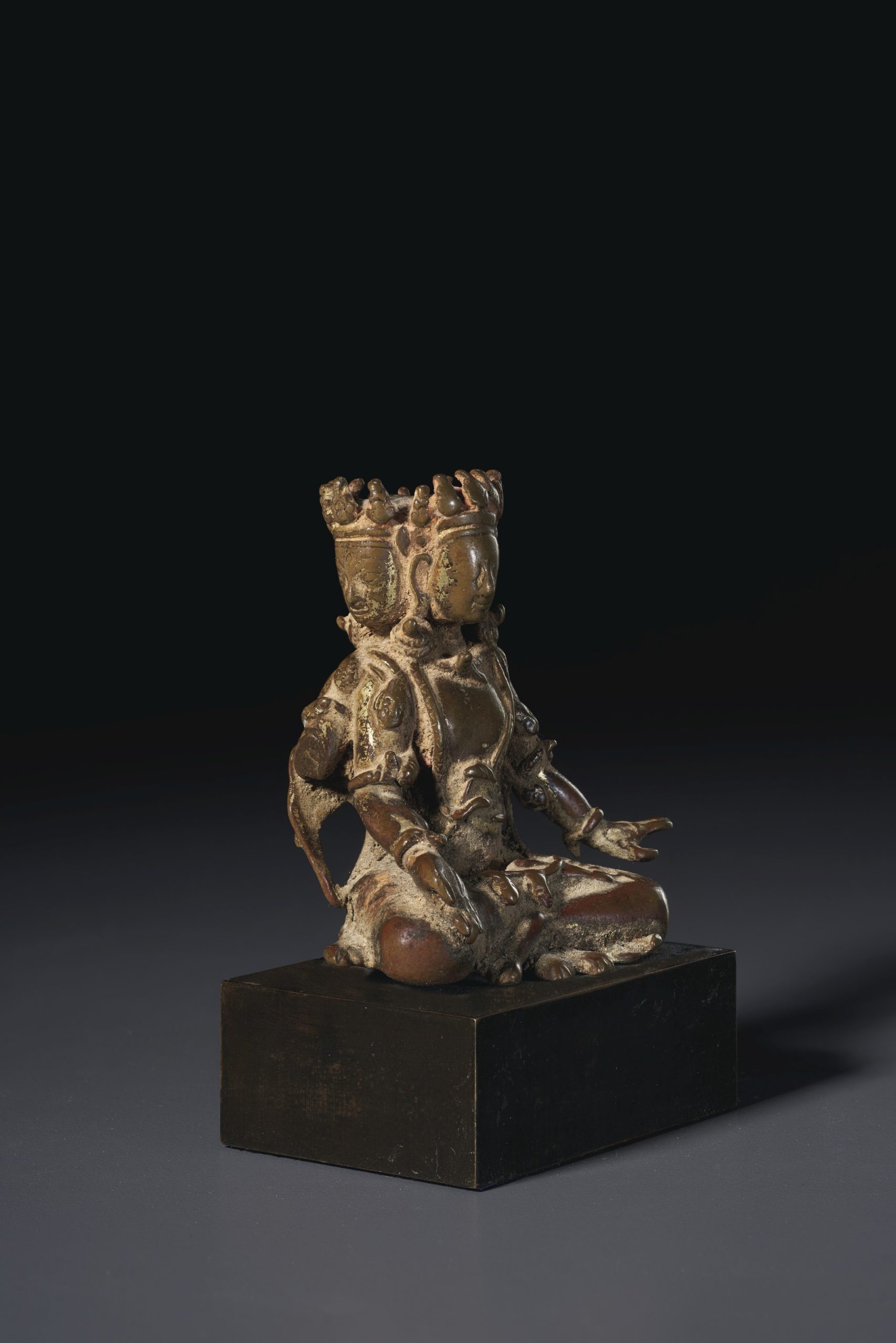
NEPAL, LICCHAVI PERIOD, 9TH CENTURY OR LATER
Price realised USD 6,000
Estimate USD 8,000 – USD 12,000
Closed: 23 Sep 2020
A GILT-COPPER FIGURE OF SADASHIVA
NEPAL, LICCHAVI PERIOD, 9TH CENTURY OR LATER
Details
A GILT-COPPER FIGURE OF SADASHIVA
NEPAL, LICCHAVI PERIOD, 9TH CENTURY OR LATER
Seated with legs crossed with the right hand extended with palm facing out and the left by his side with palm facing down, adorned with several coiled snakes and a garland of severed heads and wrapped with an elephant skin, the four faces each centered with a third eye and surmounted by a foliate tiara
2 ½ in. (6.4 cm.) high
Provenance
The James and Marilynn Alsdorf Collection, Chicago, acquired prior to 1990.
Condition of Sale
参考:佳士得
3月17日 | 现场拍卖 19562
印度、喜马拉雅及东南亚工艺精品
拍品 428
PROPERTY FROM A PROMINENT EAST COAST COLLECTION
A RARE AND IMPORTANT BRONZE FIGURE OF SAMBANDAR
SOUTH INDIA, TAMIL NADU, CHOLA PERIOD, 12TH-13TH CENTURY
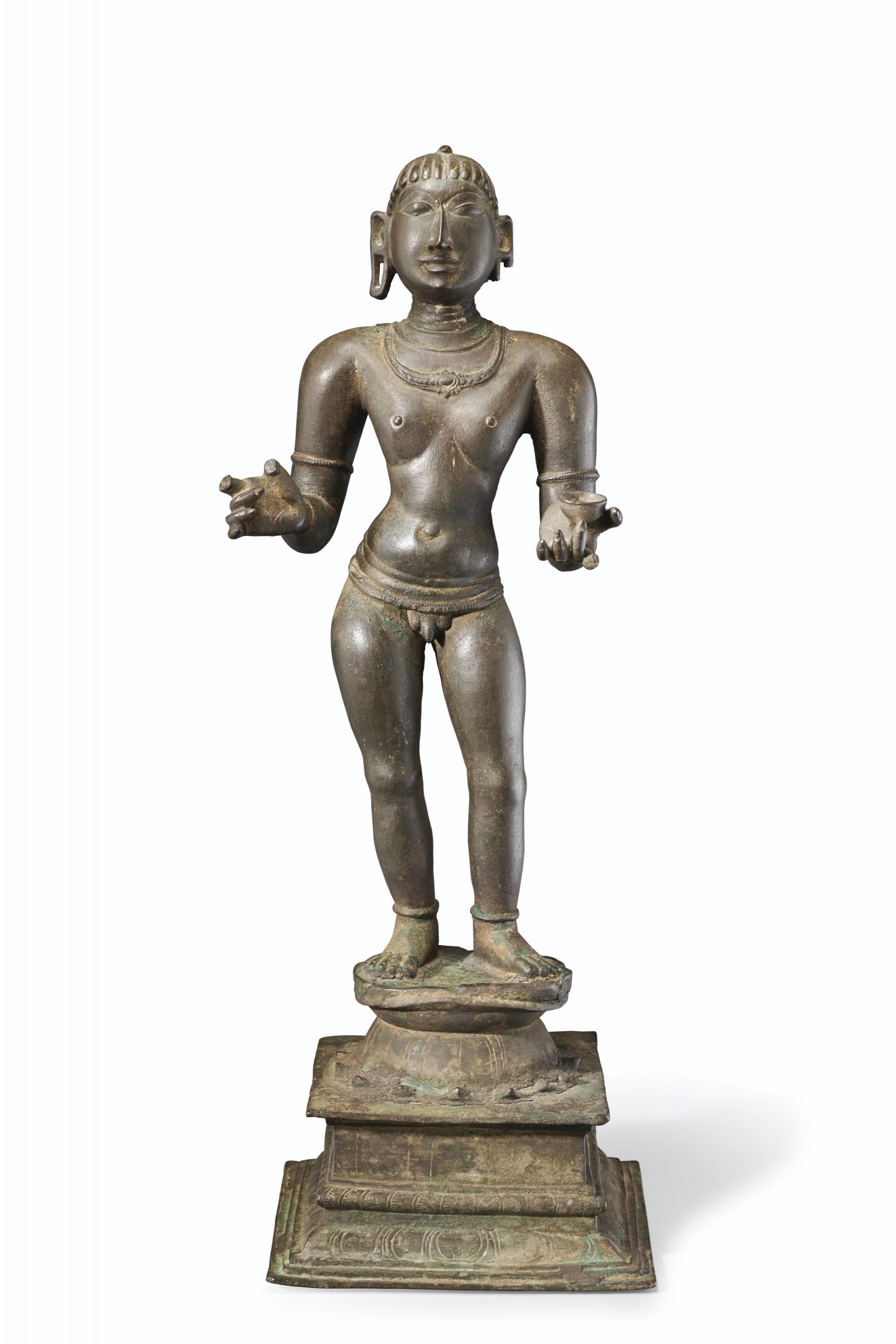
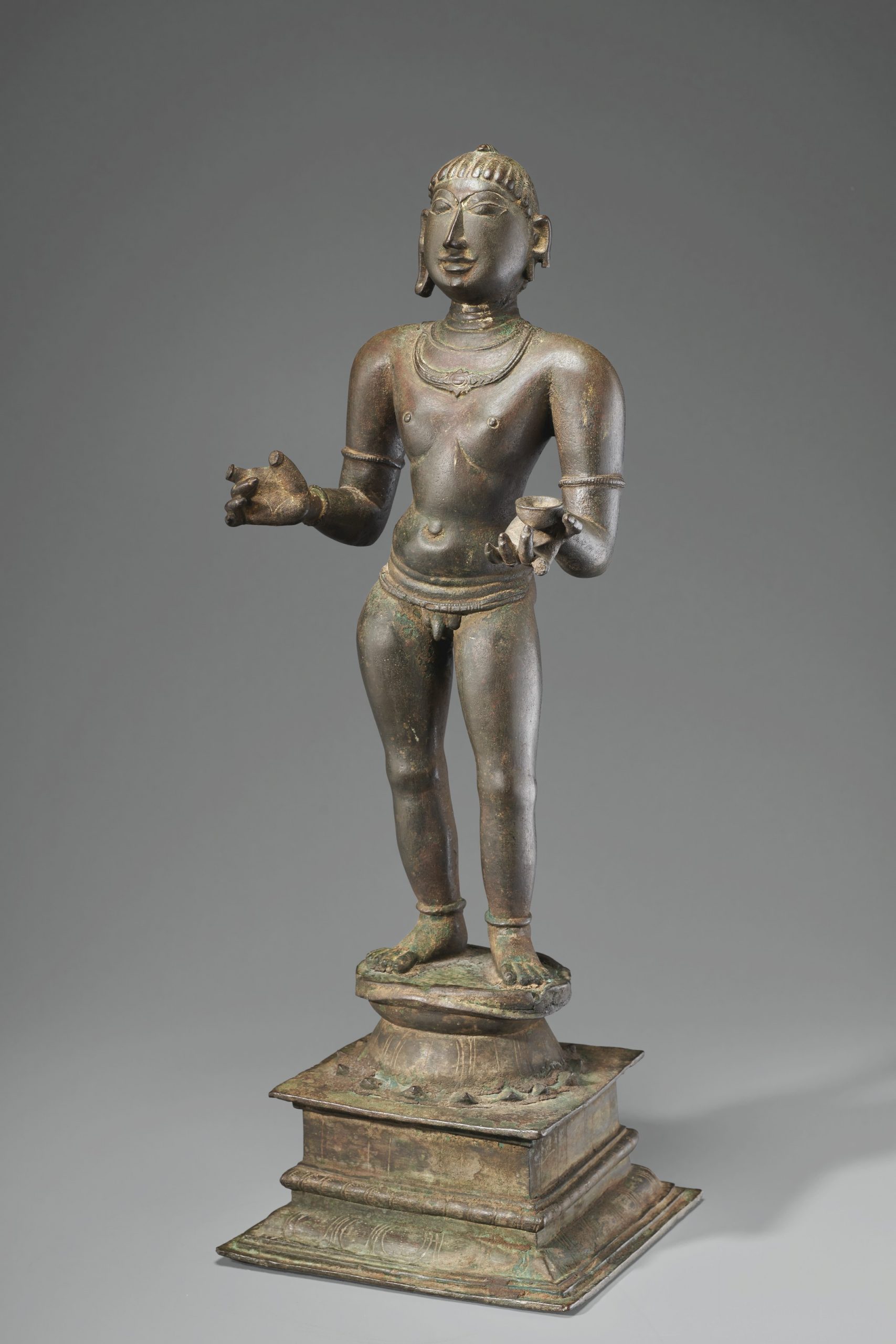
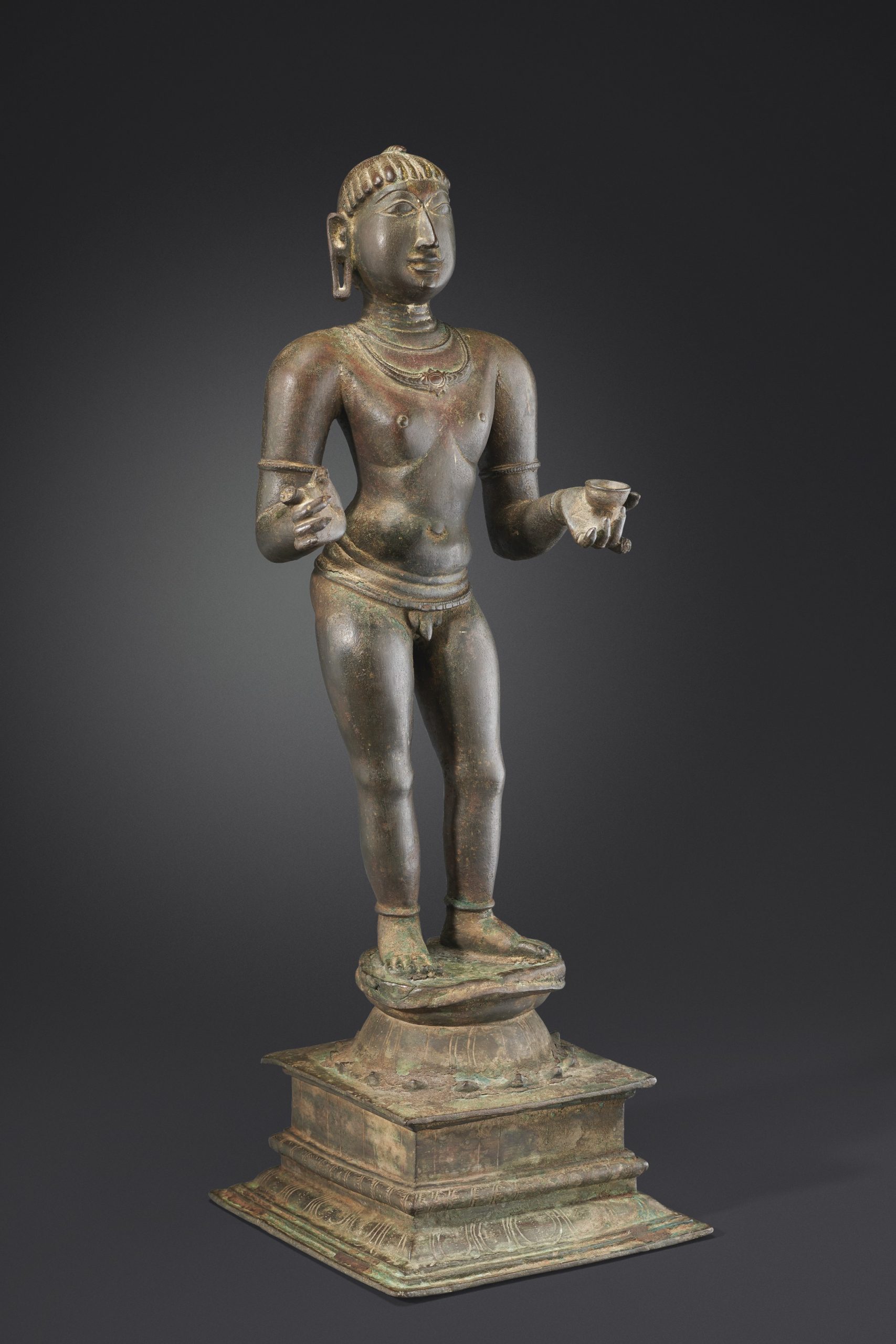
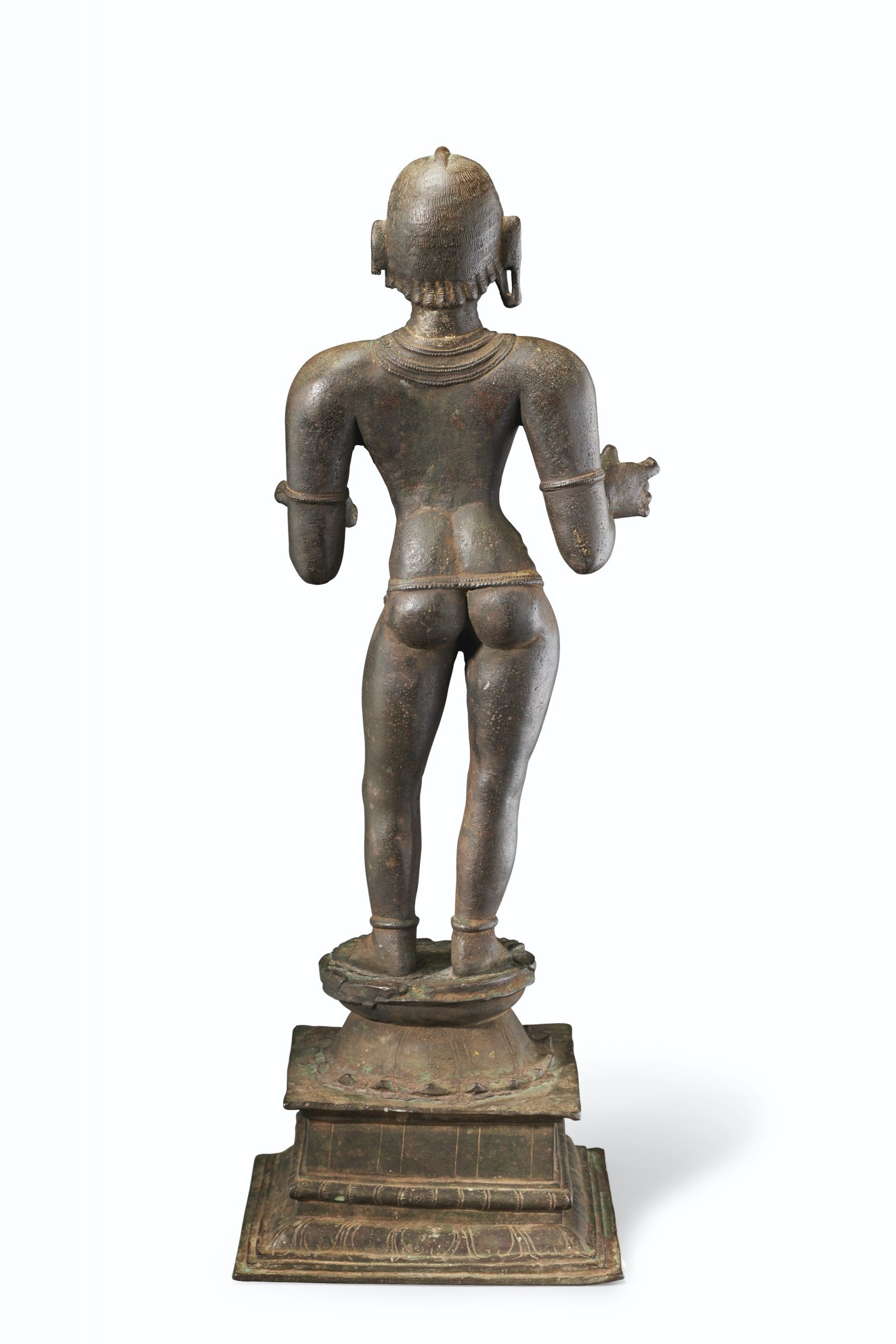
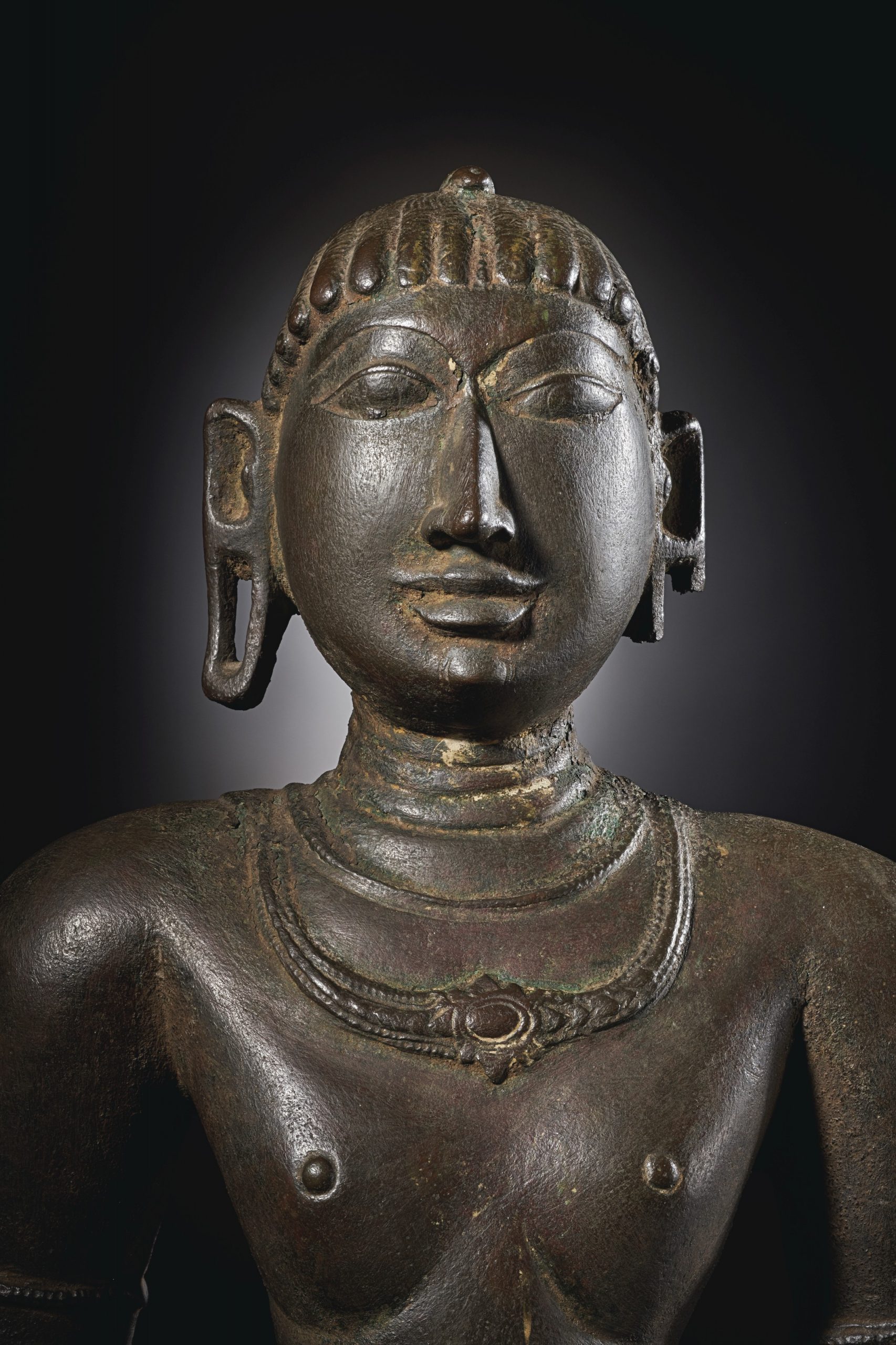
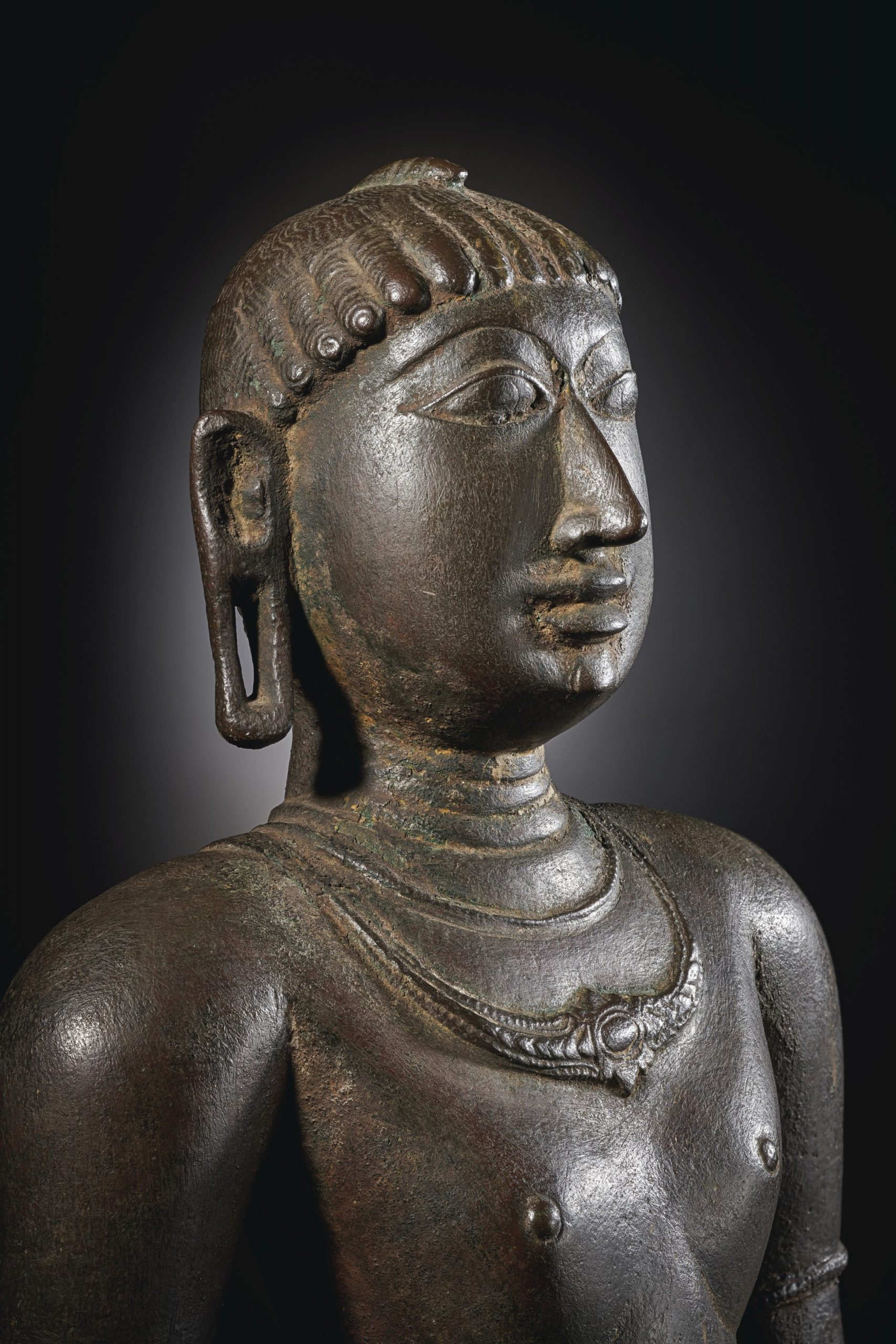
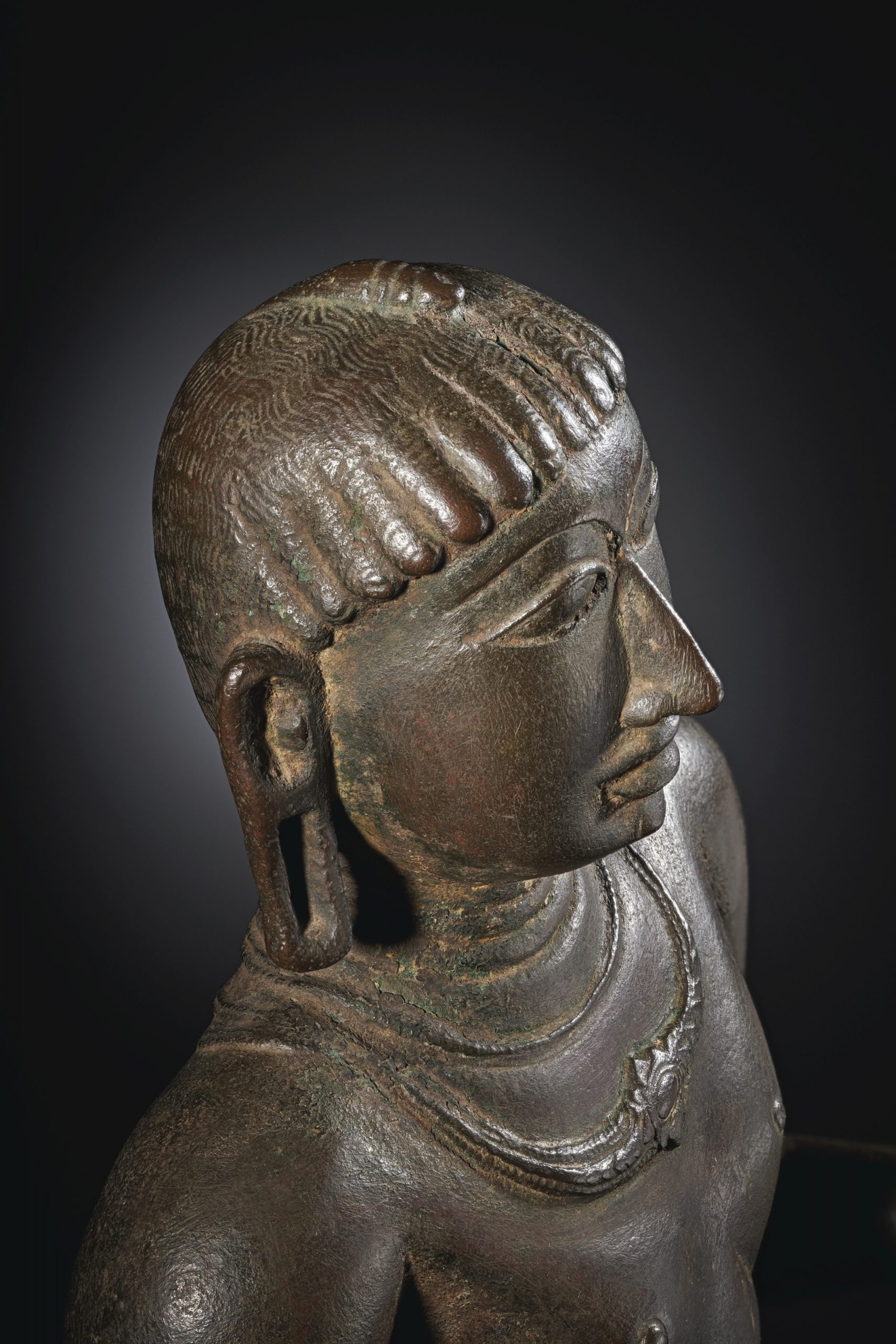
成交价 USD 1,170,000
估价 USD 700,000 – USD 900,000
拍品终止拍卖:
16 3月 2021
A RARE AND IMPORTANT BRONZE FIGURE OF SAMBANDAR
SOUTH INDIA, TAMIL NADU, CHOLA PERIOD, 12TH-13TH CENTURY
细节
27 ½ in. (69.9 cm.) high
来源
The collection of Dr. J.R. Belmont, Basel.
Sotheby’s London, 27 February 1967, lot 113.
Sotheby’s New York, 26 March 1998, lot 62.
拍品专文
This large rare and important Chola bronze figure represents the beloved child saint, Sambandar. Sambandar belongs to a group of 63 Shaiva-bhakti saints known as nyanmars, or leaders, said to have traveled from temple to temple in South India to sing Shiva’s praises. A long with Appar and Sundarar, Sambandar is one of the muvar, or three principle saints referred to as the Revered Three (or Revered Four when incorporating the later saint Manikkavacakar) of South India. These three poet-saints are considered responsible for writing the vast corpus of Shaiva hymns from the seventh through ninth centuries.
Much of what we believe about the historical Sambandar is dictated through Tamil poetry, including the Periya Puranam, an eleventh-century epic recounting the lives of the nyanmars. According to these sources, Sambandar was born of Brahmin parents in the seventh century at Sirkali, near Chidambaram, Tamil Nadu. As a young child, he frequently accompanied his father to the temple. One day, at the age of three, his father left him on the steps of the sacred tank as he entered to take his ritual bath. Outside the temple, Shiva’s consort Uma found the child crying from hunger and served him a bowl of milk from her own breast. When his father returned, he found Sambandar playing contentedly with a golden bowl while trickles of milk ran down his chin. In response to his father’s questions about the source of the milk, Sambandar burst into song and dance praising Shiva and Uma while raising his hand and pointed toward their image, thus earning his saintly status. From that moment on, he spent his days wandering South India, singing and dancing in Shiva’s honor. Sambandar lived a brief life, perishing in his teenage years; nonetheless, he is credited with having composed thousands of hymns, many still recited today.
Owing to their significant impact on Shiva-Bhakti, images of Sambandar and other saints became common in the Pallava and Chola periods and continued in popularity to this day. These images are used in festival processions alongside principle deities, often while singing the songs the poet-saints composed themselves. Inscriptions describing the many benefactions the twelfth-century Chola general made to the Nataraja Temple in Chidambaram, nearby Sambandar’s hometown, identify an image of Sambandar as well as a gold-embellished shrine to the child saint, used for the daily recitation of Sambandar’s hymns. These records, as well as the impressive bronzes that survive from the period, imply an important independent role Sambandar maintained in temple worship.
Always depicted as a child, the style of the present figure of Sambandar is typical in the Kaveri Delta region of the Chola Empire. In this image, he holds Uma’s milk cup between two fingers of his left hand, while subtly gesturing upward toward Shiva and Uma at their abode at Mount Kailash with his right. His hair is arranged in neat rows of curls, flanked by unornamented, yet elongated earlobes. He is naked, save for an infant’s girdle charmed with bells draping his hips, a bejeweled collar necklace, and simple pairs of armlets and anklets. The curling lotus petals which form the base are in a quintessentially High Chola style. The figure maintains Sambandar’s childlike qualities, with a softly modeled body and unpretentious adornment, while commanding the presence of a spiritual authority.
The present type has been previously erroneously identified as Shiva Bhikshatana (lot 429), since both representations share aspects of nudity and the kapala-like cup. Representations of Sambandar in the present form are rare; the child saint is easily more recognizable in bronze images of him in the dancing posture, likened to images of the child Krishna dancing and trampling the serpent Kaliya. Compare the present figure to a eleventh-century figure of Sambandar at the Metropolitan Museum of Art (acc.no. 2010.230). Both figures are impressive in their size, and are close comparisons in style and composition, differing only in subtle details such as Sambandar’s necklace and curls.
参考:佳士得
16 3月 2021 | 现场拍卖 19562
印度、喜马拉雅及东南亚工艺精品
拍品 444 喀什米爾或西藏西部
十/十一世紀 銅嵌銀及紅銅釋迦牟尼佛像
A SILVER- AND COPPER-INLAID BRONZE FIGURE OF BUDDHA SHAKYAMUNI
PROPERTY FROM THE ESTATE OF BARONESS EVA BESSENYEY
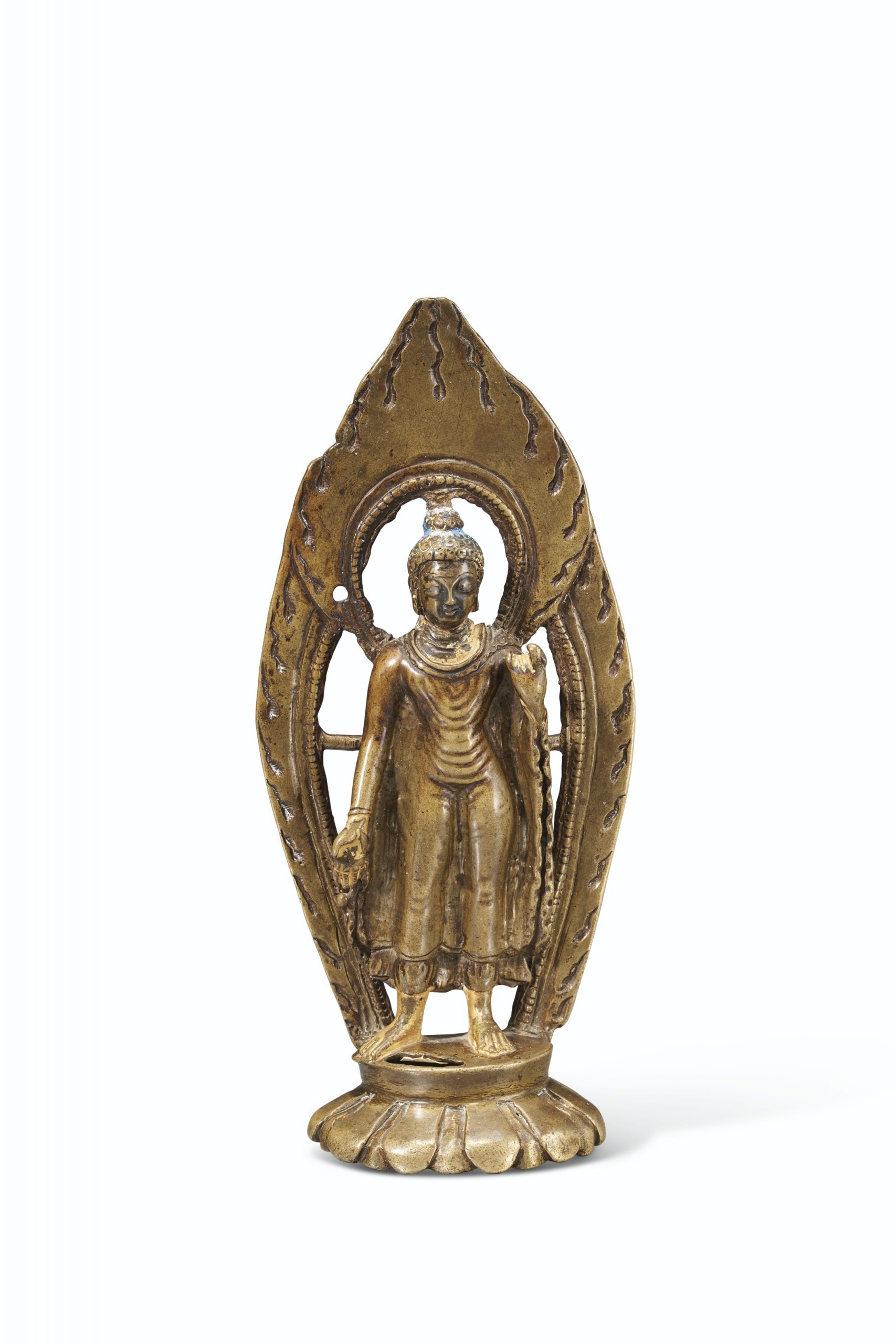
銅嵌銀及紅銅釋迦牟尼佛像A SILVER- AND COPPER-INLAID BRONZE FIGURE OF BUDDHA SHAKYAMUNI
PROPERTY FROM THE ESTATE OF BARONESS EVA BESSENYEY
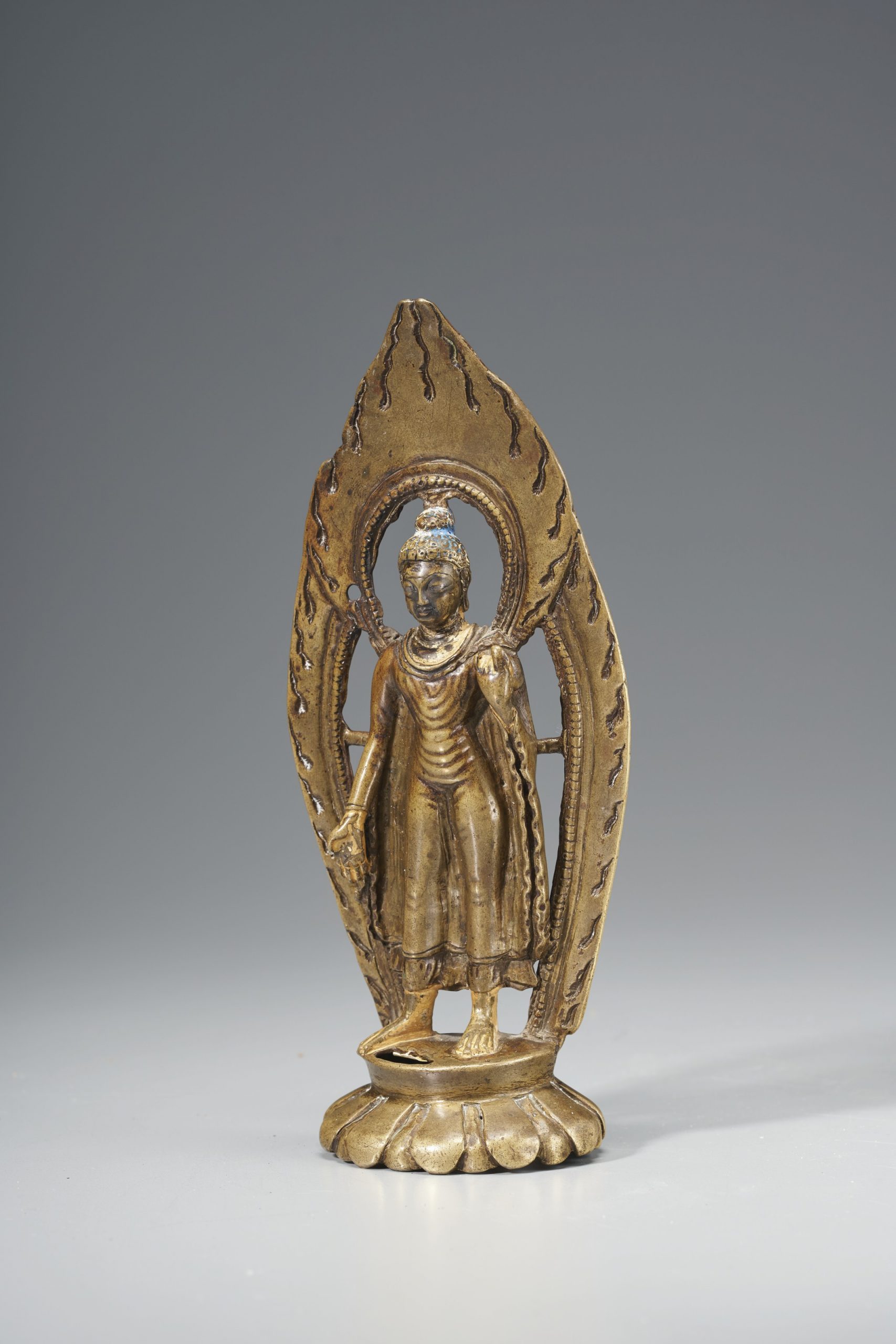
銅嵌銀及紅銅釋迦牟尼佛像 A SILVER- AND COPPER-INLAID BRONZE FIGURE OF BUDDHA SHAKYAMUNI
PROPERTY FROM THE ESTATE OF BARONESS EVA BESSENYEY
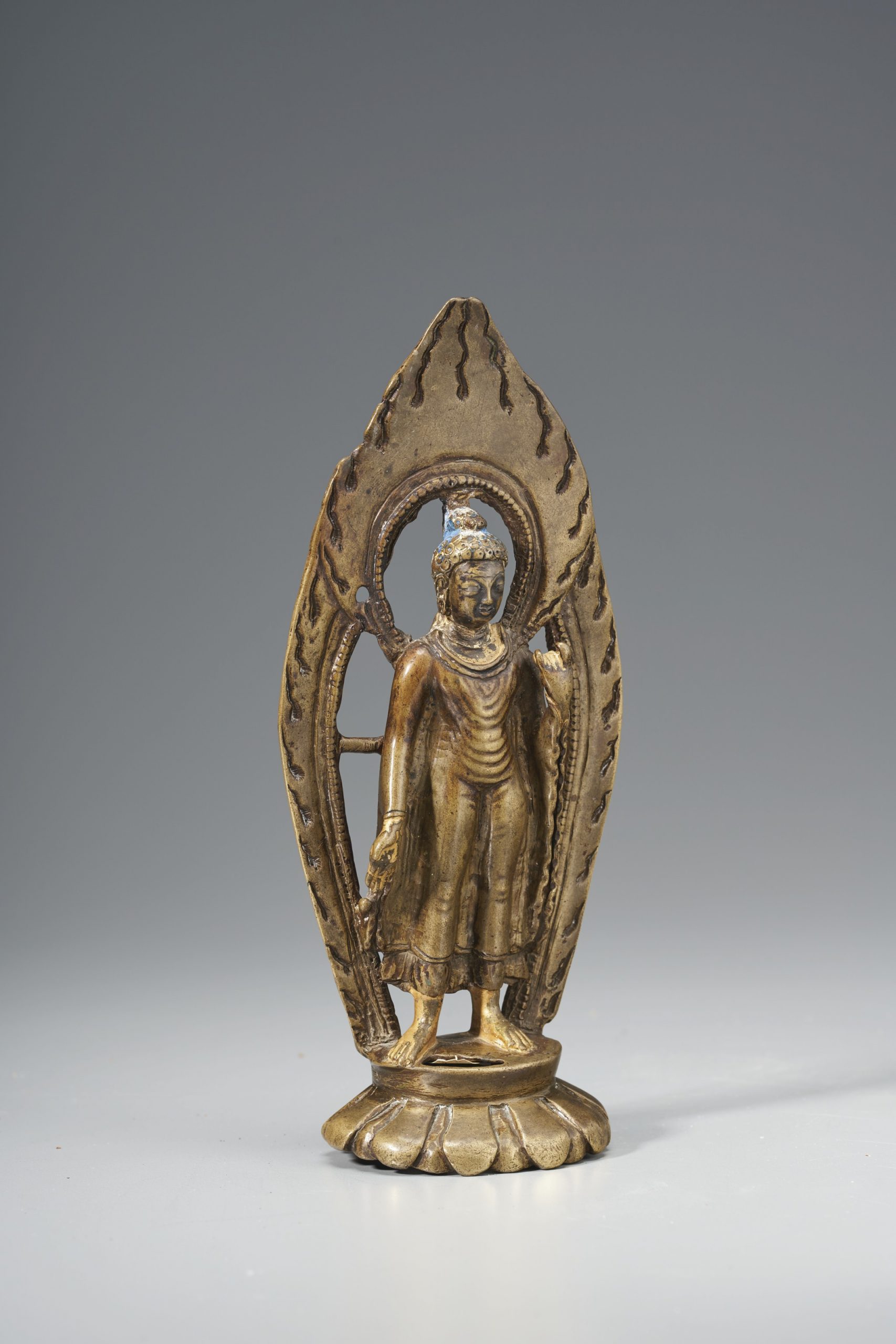
銅嵌銀及紅銅釋迦牟尼佛像 A SILVER- AND COPPER-INLAID BRONZE FIGURE OF BUDDHA SHAKYAMUNI
PROPERTY FROM THE ESTATE OF BARONESS EVA BESSENYEY
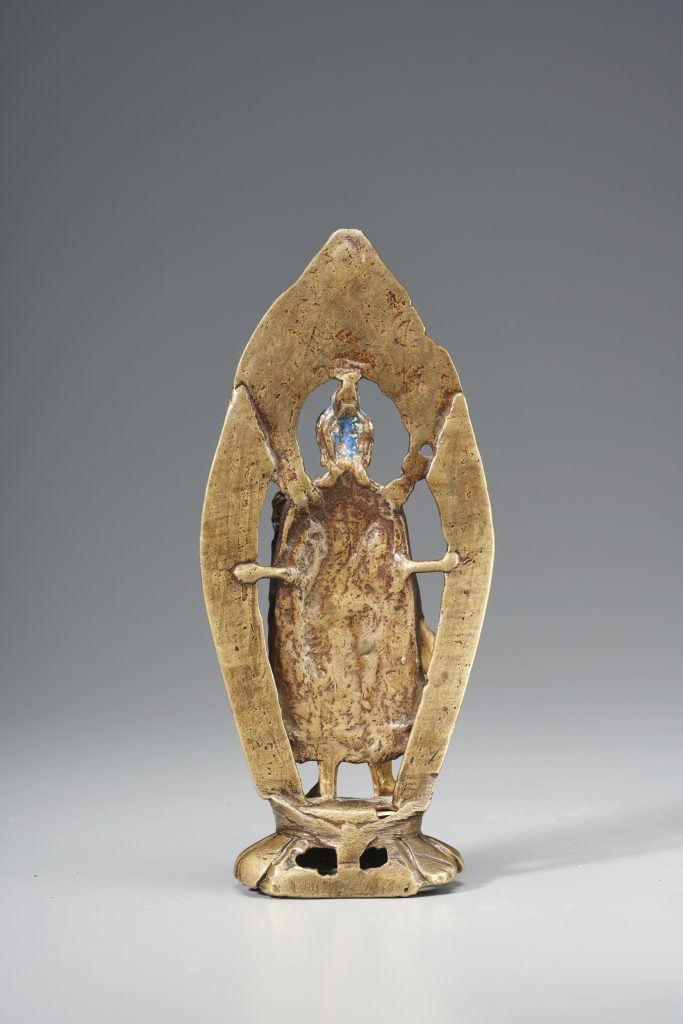
銅嵌銀及紅銅釋迦牟尼佛像
成交价 USD 15,000
估价 USD 15,000 – USD 20,000
A SILVER- AND COPPER-INLAID BRONZE FIGURE OF BUDDHA SHAKYAMUNI
KASHMIR OR WESTERN TIBET, 10TH-11TH CENTURY
喀什米爾或西藏西部 十/十一世紀 銅嵌銀及紅銅釋迦牟尼佛像
7 ½ in. (19 cm.) high
來源
私人珍藏,倫敦,不晚於1981年(傳)。
紐約蘇富比,2004年9月24日,拍品57。
出版
烏爾裡希•馮•施羅德,《印度與西藏的銅造像》,香港,1981年,頁133,圖錄編號23B。
“喜馬拉雅藝術資源”(Himalayan Art Resources),編號24487。
U. von Schroeder, Indo-Tibetan Bronzes, Hong Kong, 1981, p. 133, fig. 23B.
Himalayan Art Resources, item no. 24487.
拍品专文
这尊释迦牟尼佛雕像呈现出轻微的三弯身姿,右手向前展示着庇护授予的手势,左手抓住他宽松的袈裟褶皱。他的嘴唇看起来紧闭,与他丰满的垂耳和大杏仁形状的眼睛相匹配。他头顶的发丝上留有一些蓝色颜料痕迹,残余的冷色金表明曾经覆盖在他的身体上。这种黄铜合金的材质和圆润的脸庞塑造方式,以及宽阔的银嵌眼睛,让人联想到出现在公元八世纪初的克什米尔原型。此外,该雕像的侧面轮廓,从额头到鼻尖可以画出一条直线,符合克什米尔的传统。因此,面部特征的比例和呈现方式与克利夫兰艺术博物馆的一尊克什米尔佛像(编号1966.3),据铭文可追溯到公元十一世纪上半叶或更早时期,十分相似。
这尊雕塑以其优美而保守的表现形式与克什米尔早期的杰作有所不同,后者以夸张的特征为特点。与许多这类青铜雕像一样,这尊雕塑是在克什米尔创造的,还是在西藏西部的克什米尔工作室创造的,尚不清楚,因为古格和拉达克王国在公元950-1200年间的第二次传播时期,即所谓的西藏文艺复兴时期,与克什米尔有着密切的商业联系。
The present figure of Buddha Shakyamuni stands in a slight tribhanga with his right hand forward-facing in the refuge-granting gesture and the left clutching the folds of his billowing sanghati. His lips appear pursed, matching the fullness of his pendant earlobes and large almond-shaped eyes. Traces of blue pigment remain on his curl-topped ushnisha and the remnants of cold gold indicate that it once covered his body. The brassy metal alloy, and manner of modeling the rounded face with wide, silver-inlaid eyes, is reminiscent of Kashmiri prototypes that began appearing at the turn of the eighth century. Moreover, the figure’s profile, upon which a straight line can be drawn from the forehead to the tip of the nose, is attributable to Kashmiri convention. As such, the proportions and rendering of the facial features closely resemble a standing Kashmiri buddha attributed by inscription to the first half of the eleventh century or earlier at the Cleveland Museum of Art (acc. no. 1966.3).
The present sculpture, with its graceful and restrained representation, differs from the early masterpieces of Kashmir which are defined by exaggerated features. As with many bronzes of this type, it is unclear whether the present sculpture was created in Kashmir or in the Kashmiri ateliers of Western Tibet, as the Kingdoms of Guge and Ladakh had close commercial ties with Kashmir during the period of the second dissemination known as the Tibetan Renaissance (c. 950-1200 CE).
参考:北京故宫
唐铜鎏金立像
文物号新 00116532
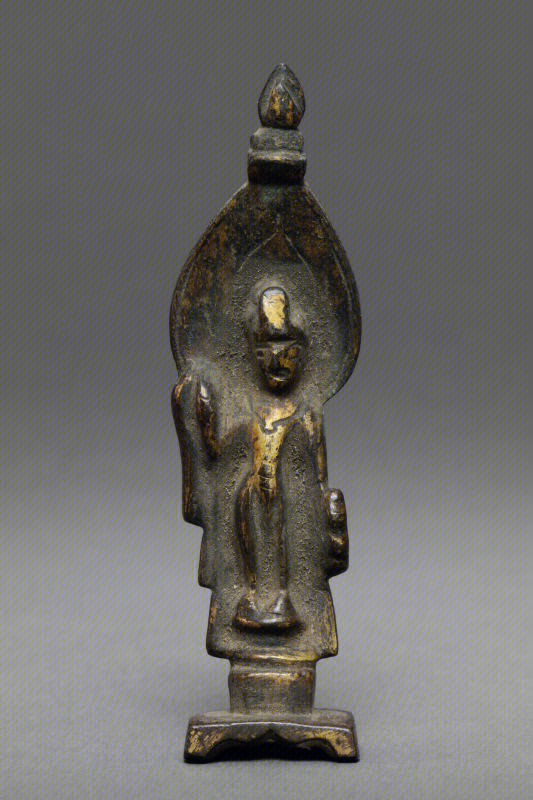
参考: 苏富比 642
中國藝術品
或唐 鎏金銅佛立像一對
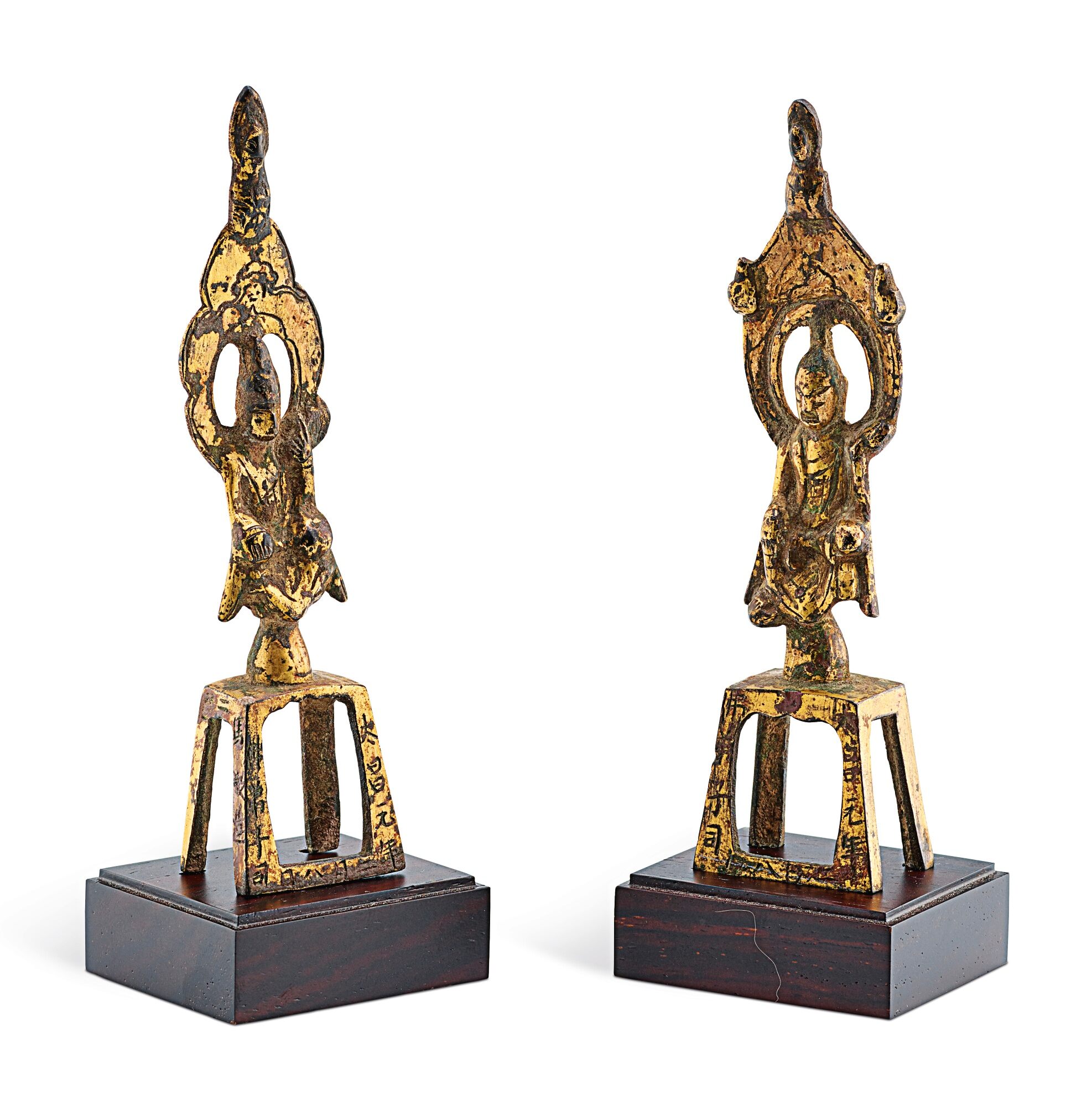
70,000 — 90,000港幣
拍品詳情
或唐 鎏金銅佛立像一對
11.4 公分,4 1/2 英寸
後加銘文:太昌元年二月八日、佛弟子司、區二馬敬造
中國藝術品
2018年5月31日 – 2018年6月1日 | 上午 11:15 HKT
香港
参考: 苏富比 3202
藝海觀濤:坂本五郎珍藏早期佛教銅像
五胡十六國四至五世紀初 鎏金銅釋迦牟尼佛坐像
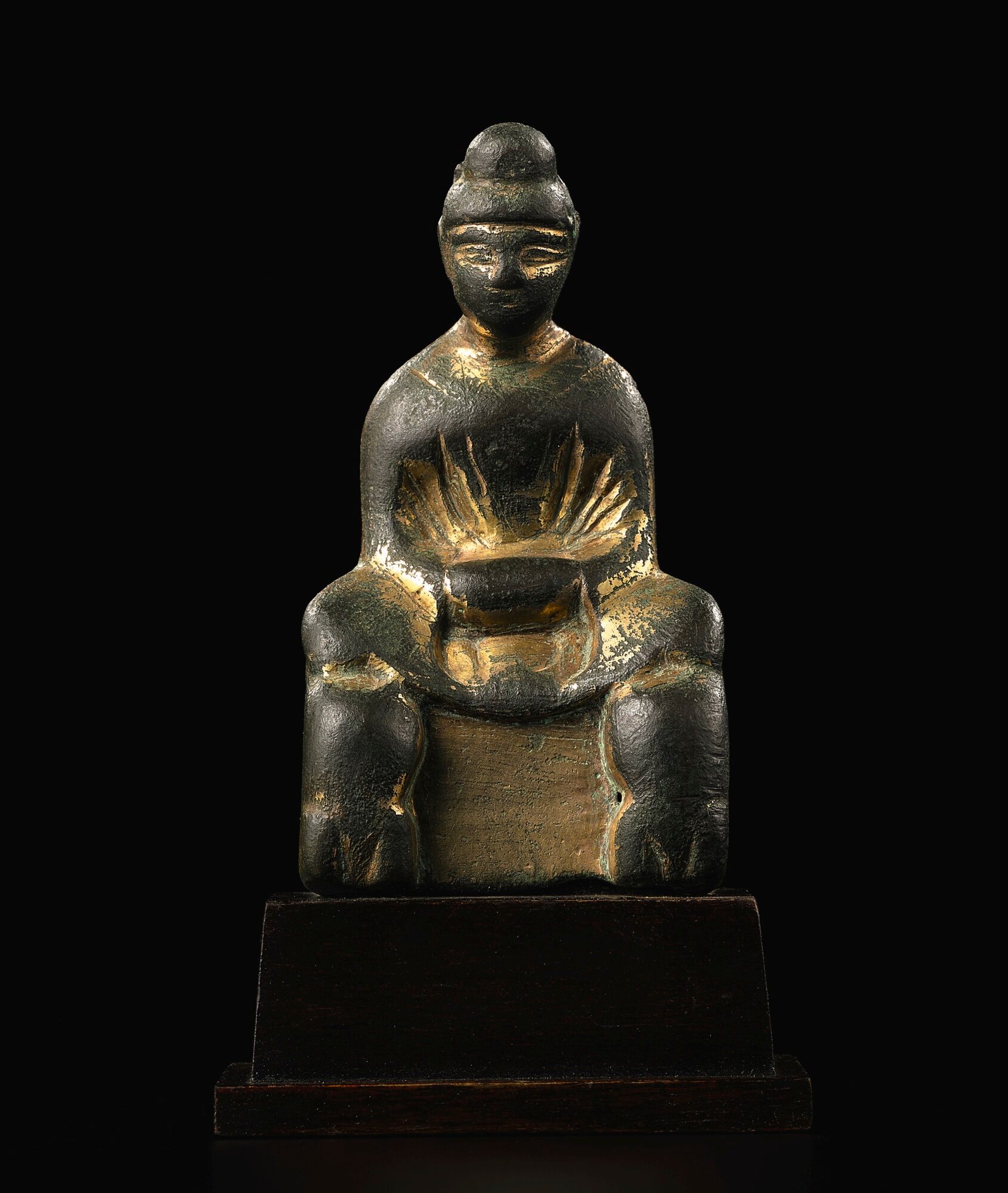
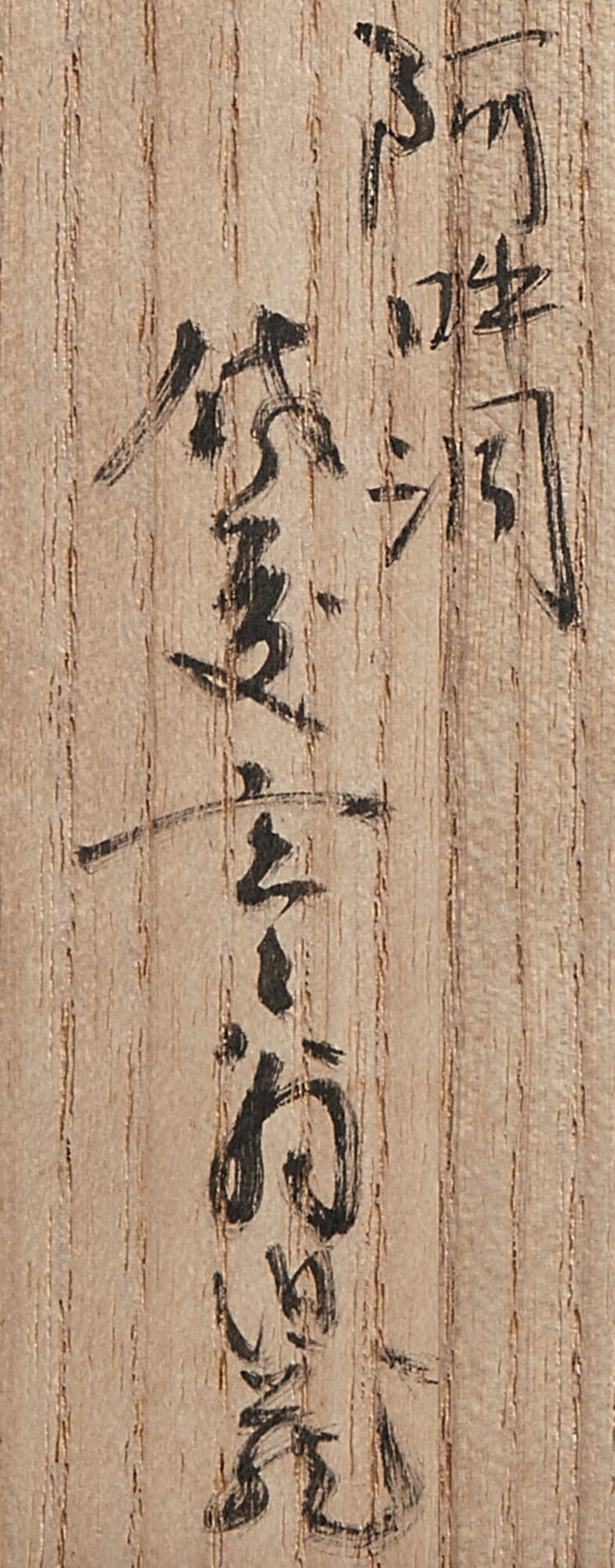
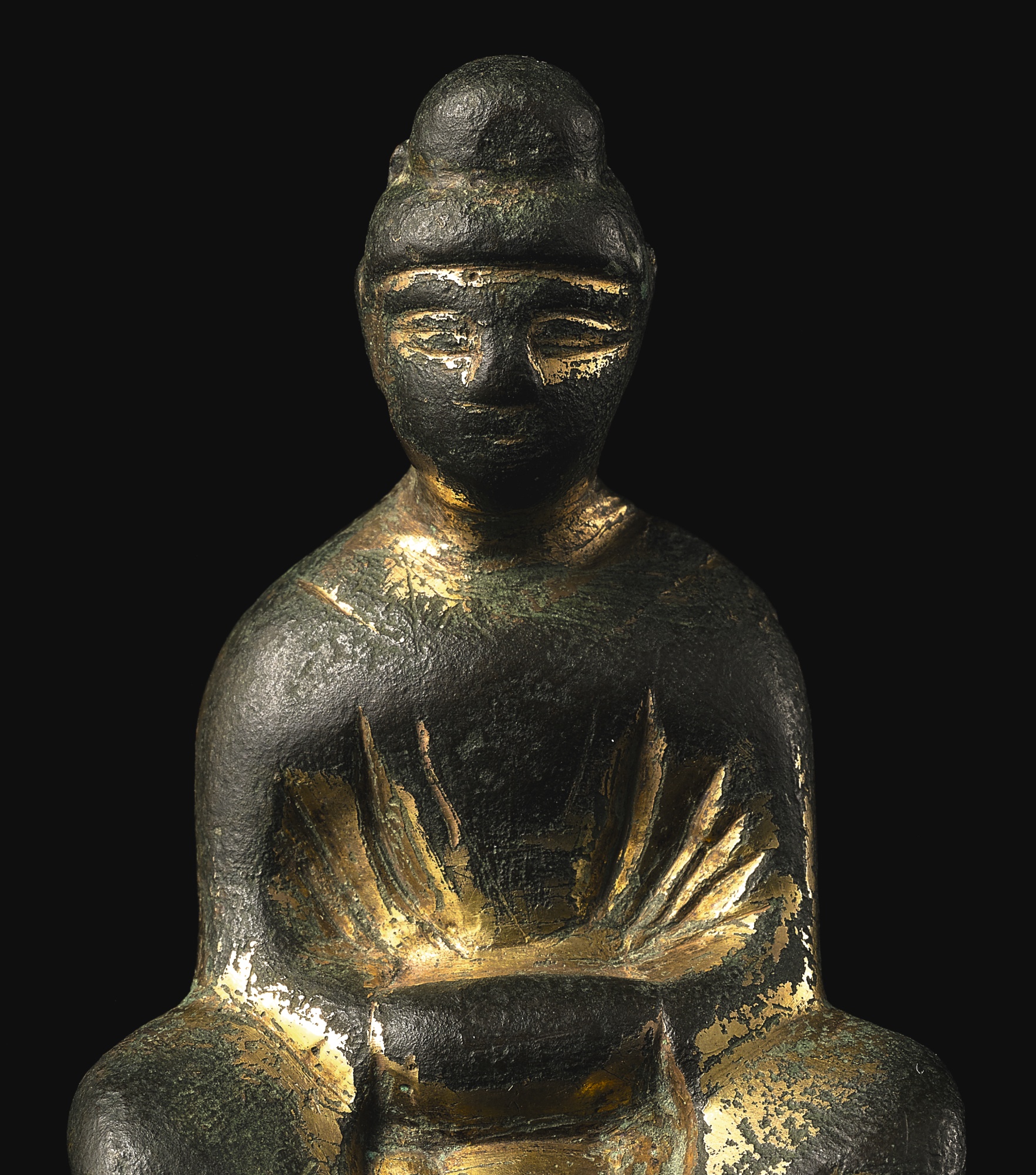
40,000 — 60,000港幣
拍品已售 137,500 港幣 成交價 (含買家佣金)
拍品詳情
五胡十六國四至五世紀初 鎏金銅釋迦牟尼佛坐像
7.7 公分,3 英寸
來源
佐藤玄々(1888-1963年)收藏
東京佳士得1970年5月27日,編號193
藝海觀濤:坂本五郎珍藏早期佛教銅像
2016年10月5日 | 下午 12:15 HKT
香港
参考: 苏富比 3206
藝海觀濤:坂本五郎珍藏早期佛教銅像
北魏太和廿一年 銅釋迦多寶二佛並坐像
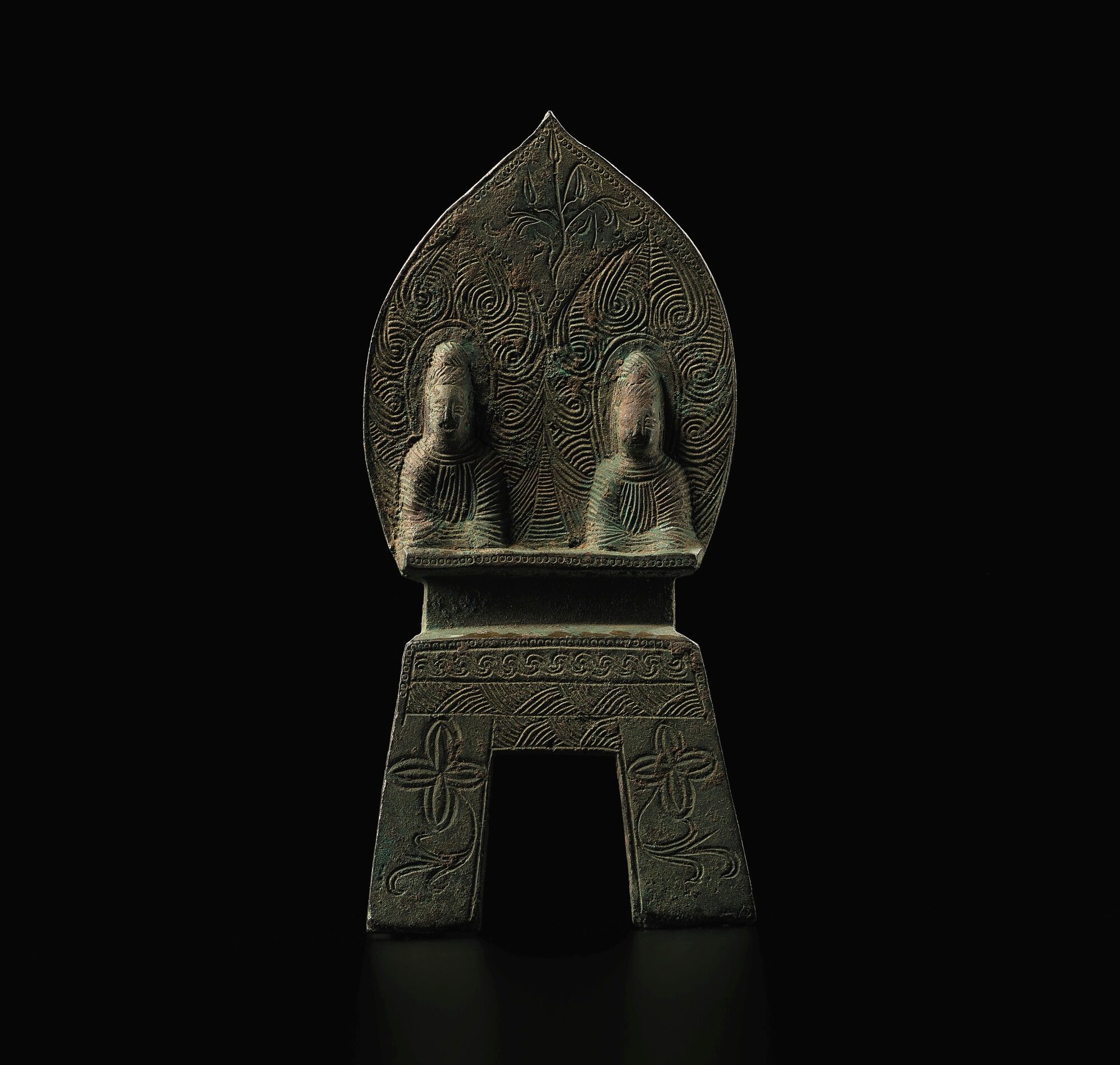
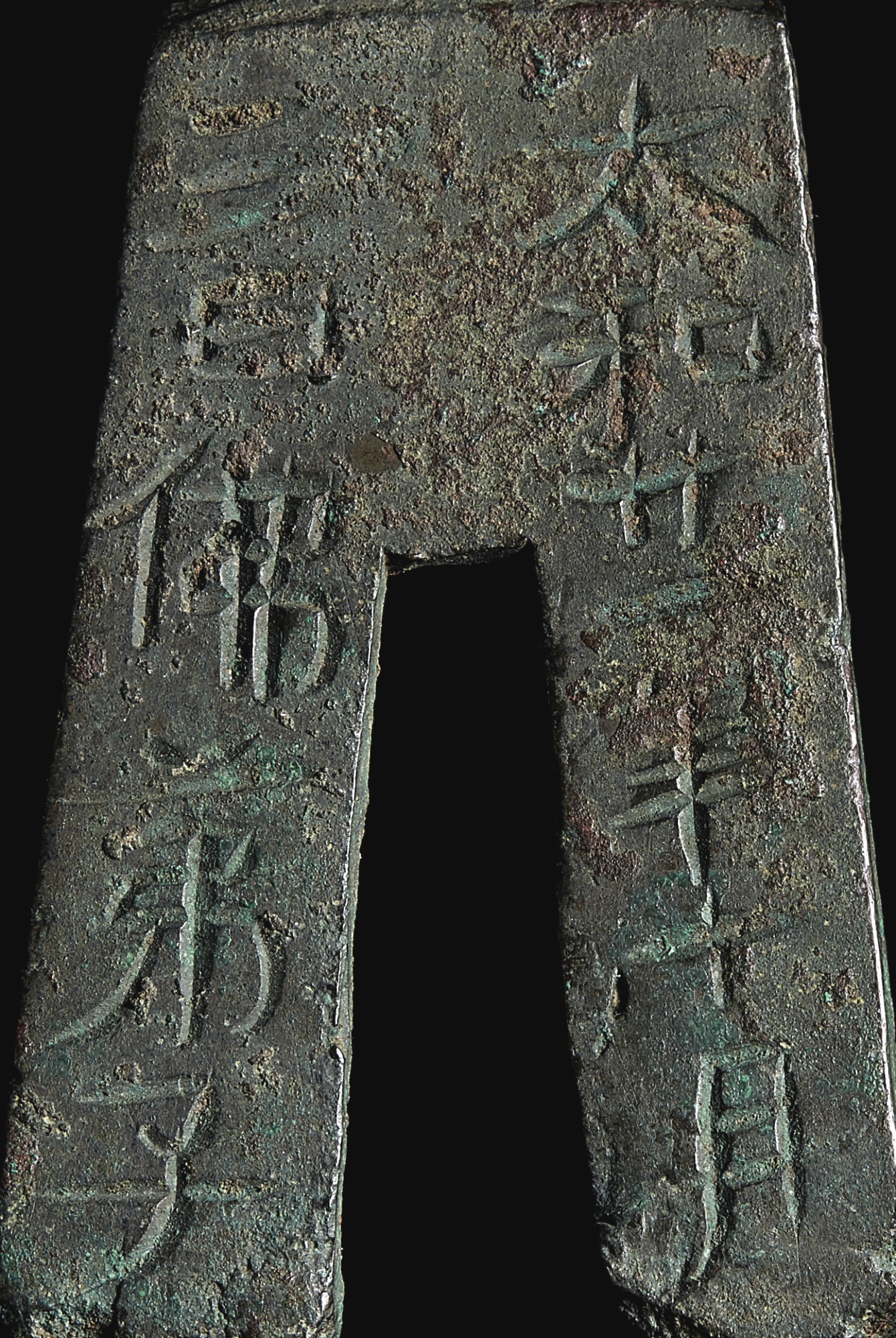
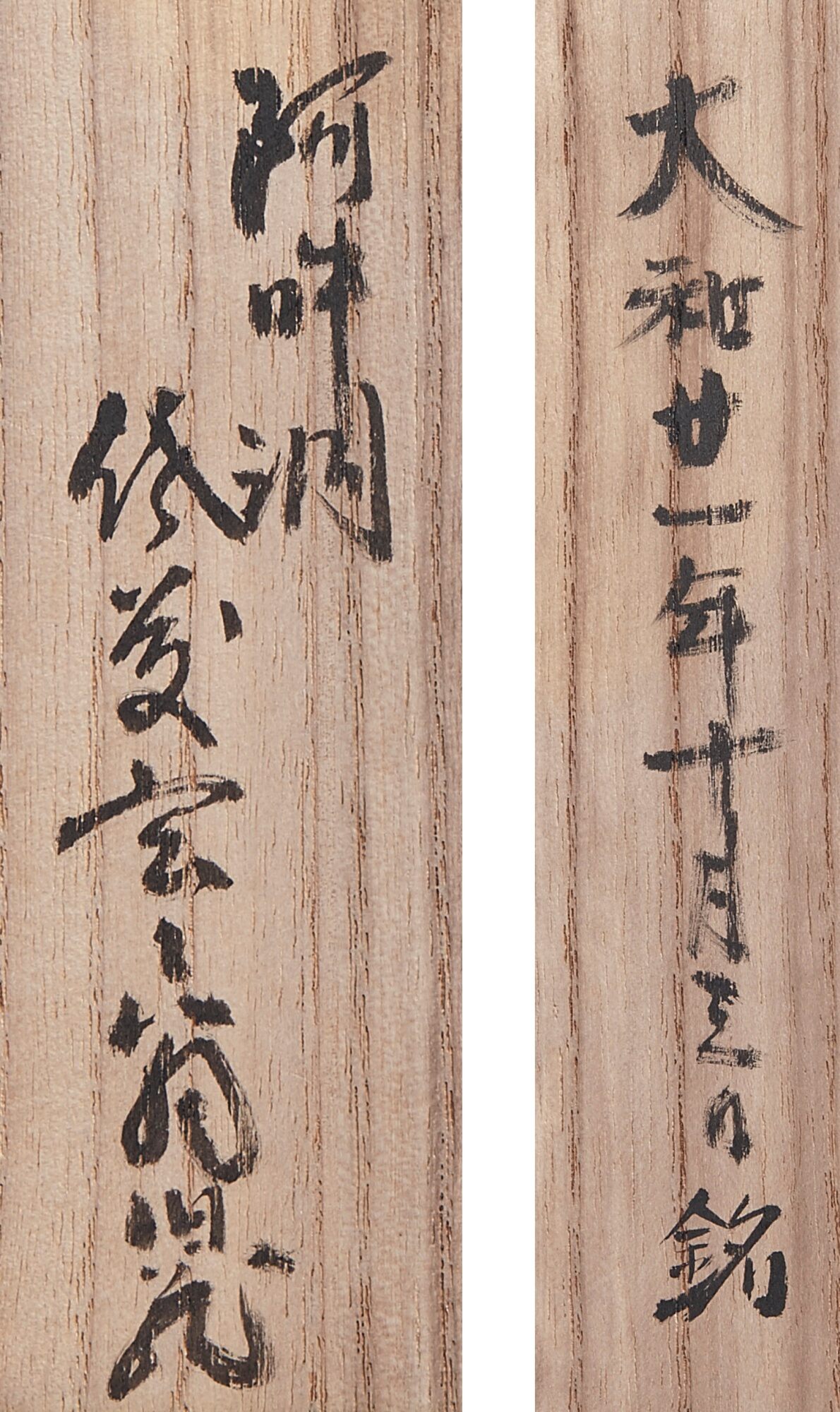
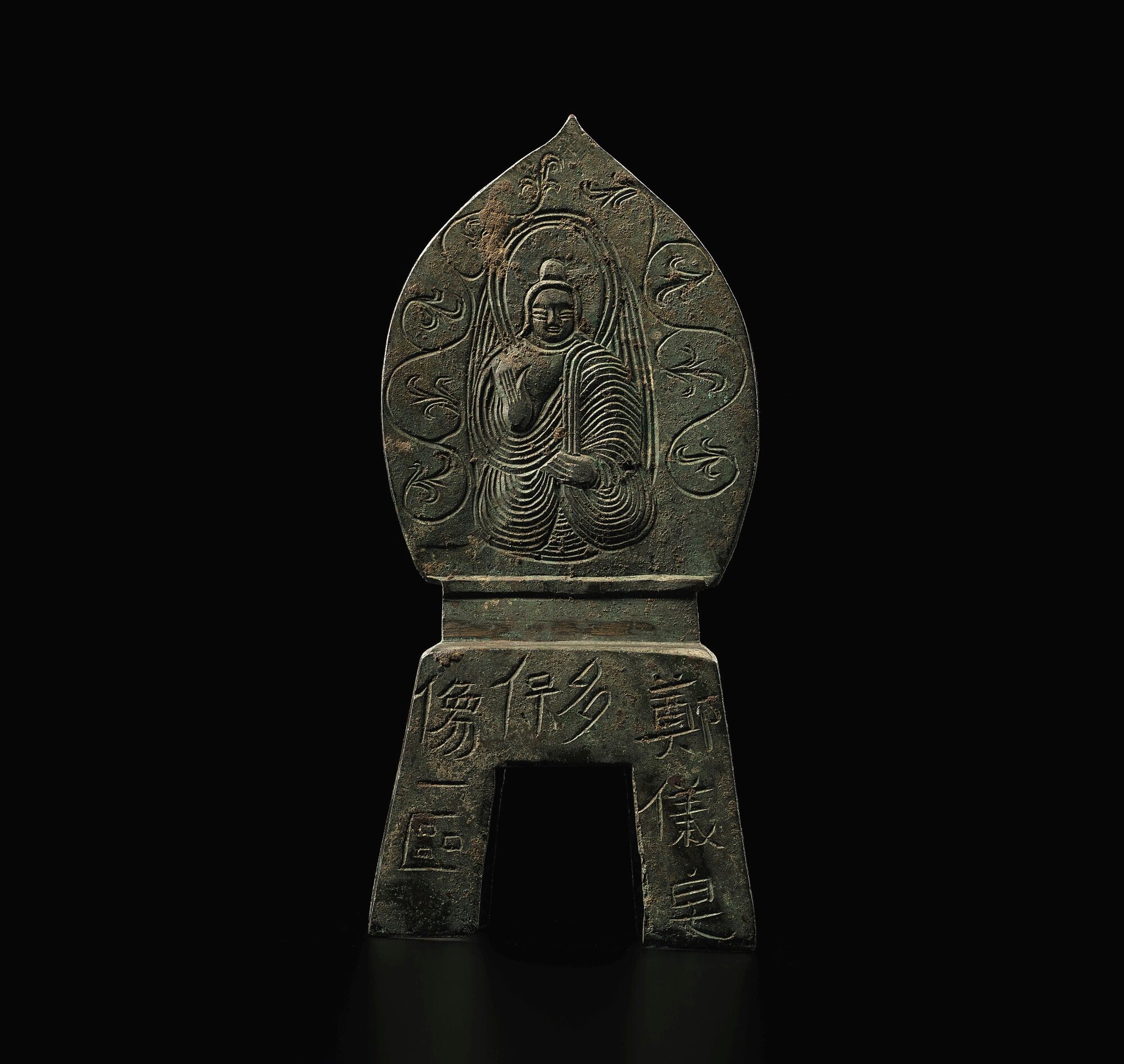
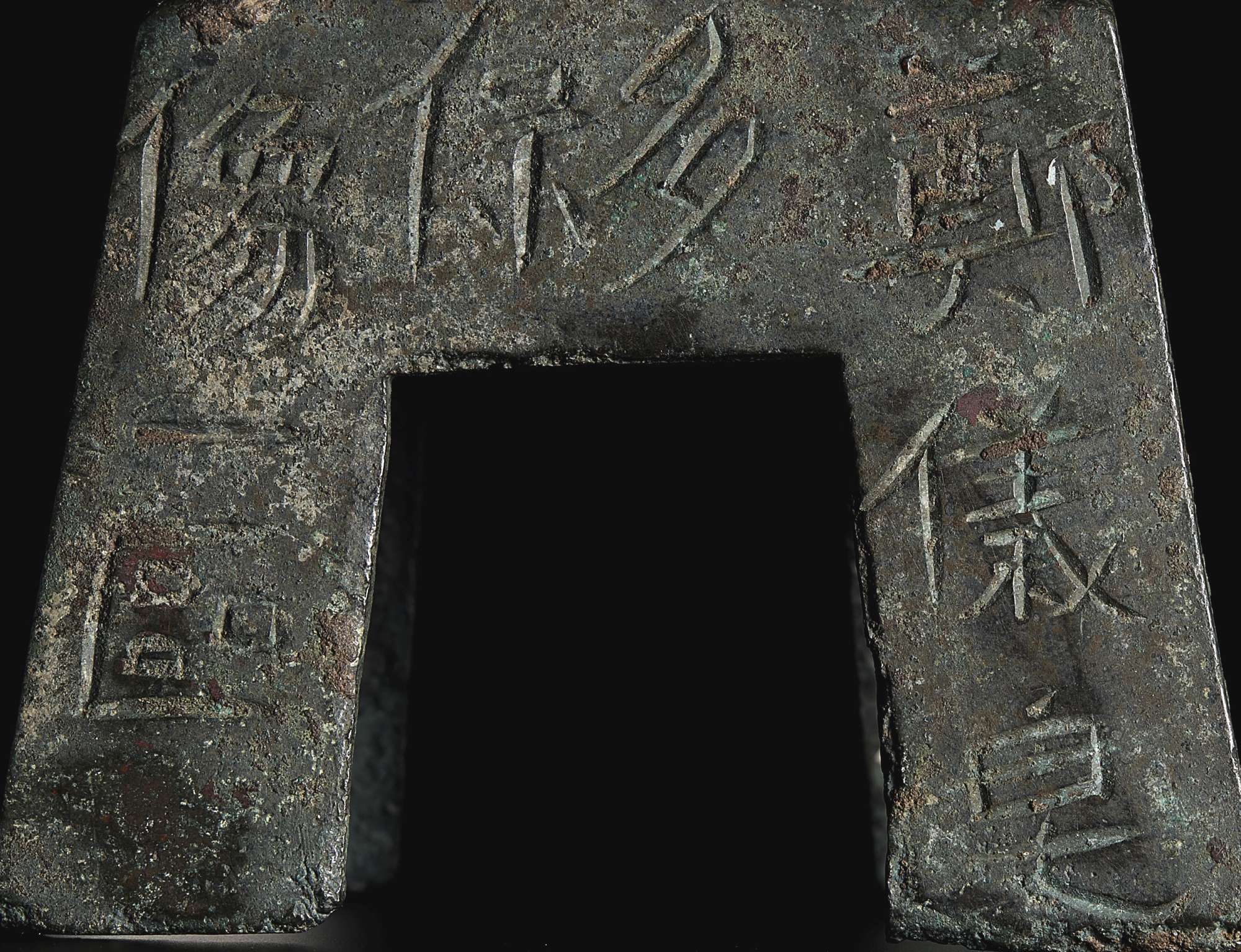
30,000 — 40,000港幣
拍品已售 2,360,000 港幣 成交價 (含買家佣金)
拍品詳情
北魏太和廿一年 銅釋迦多寶二佛並坐像
銘文:太和廿一年十月三日佛弟子鄭儀皂多保像一區。
15.3 公分,6 英寸
狀況報告
來源
古河虎之助男爵(1887-1940年)收藏
佐藤玄々(1888-1963年)收藏
出版
《東洋美術大觀》,卷13,東京,1915年,圖版90及91
大村西崖,《支那美術史彫塑編》,東京,1915年,圖版491
松原三郎,《中国佛教彫刻史研究》,東京,1961年,圖版44b及c
松原三郎,《增訂中国佛教彫刻史研究》,東京,1966年,圖版43b及c
松原三郎,《中国佛教彫刻史論》,東京,1995年,卷1,圖版82c及d
藝海觀濤:坂本五郎珍藏早期佛教銅像
2016年10月5日 | 下午 12:15 HKT
香港
参考:佳士得拍賣 2640
Doris Wiener珍藏
紐約|2012年3月20日
拍品40 10世纪克什米尔 弥勒佛铜立佛
A large bronze figure of Maitreya
KASHMIR, 10TH CENTURY
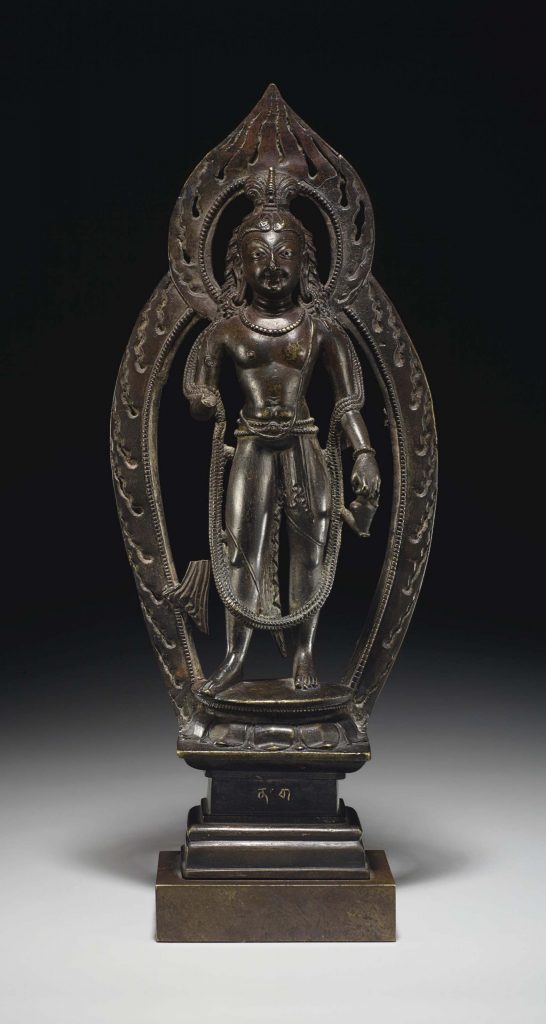
成交總額
USD 74,500
估價
USD 80,000 – USD 120,000
A large bronze figure of Maitreya弥勒佛
Kashmir, 10th century
Standing on a lotus base over a stepped plinth, holding the water pot in his pendant left hand, clad in a short dhoti secured with a beaded belt, adorned with a foliate garland, sacred thread, and a beaded necklace, the face with aquiline nose and almond-shaped eyes, the hair pulled into a topknot and secured with a stupa finial, backed by a flaming nimbus and aureole, the base with an inscription
14½ in. (36.8 cm.) high
來源
Private Collection, Switzerland
Doris Wiener Gallery, New York, before 1970
拍品專文
The small inscription at the front of the base is in the Tibetan script, and reads “na.ga.” As evinced by Ian Alsop, this is a reference to Nagaraja, a powerful “royal monk” who lived from 988 to 1026. The son of Ye she ‘od, king of Guge in Western Tibet, Nagaraja amassed a sizeable number of Kashmiri and Western Tibetan Buddhist bronzes for his personal collection, stamping each one with his name as an indication of this religious endeavor. For another example with a Nagaraja inscription, see U. von Schroeder, Indo-Tibetan Bronzes, 1981, p. 149, cat. no. 26G, also sold at Christie’s, New York, 22 March 2011, lot 464; for a similar figure of Maitreya, see U. von Schroeder, Indo-Tibetan Bronzes, 1981, p. 127, cat. no. 20E.
参考:东京中央(香港)
2017秋季拍卖会
中国重要瓷器及艺术品
东魏 铜制净瓶观音立像
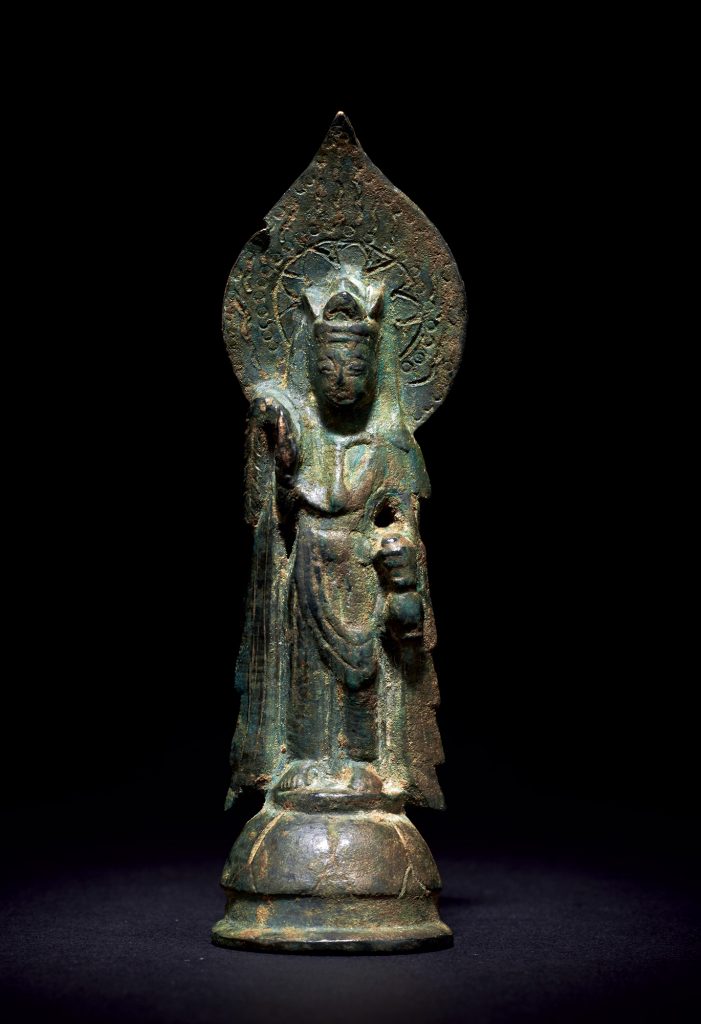
拍卖信息
Lot 717 东魏 铜制净瓶观音立像
估价:30,000-50,000 HKD
未成交
尺寸:高9.5cm
拍品说明:
来源:日本旧藏。
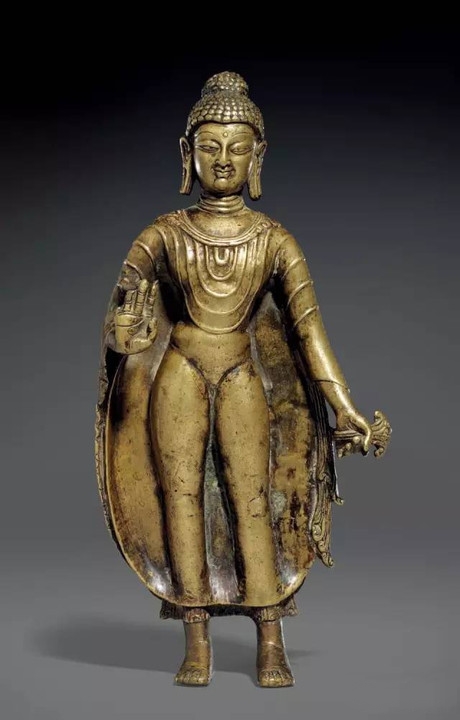
高26.3 cm
估价:100,000-150,000美元
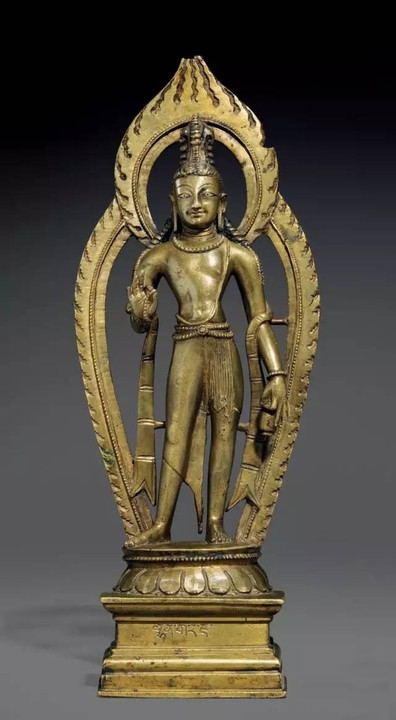
高31.7 cm
估价:200,000-300,000美元
Lot 91 A COPPER ALLOY FIGURE OF BUDDHA
Kashmir or Himachal Pradesh, circa 11th century
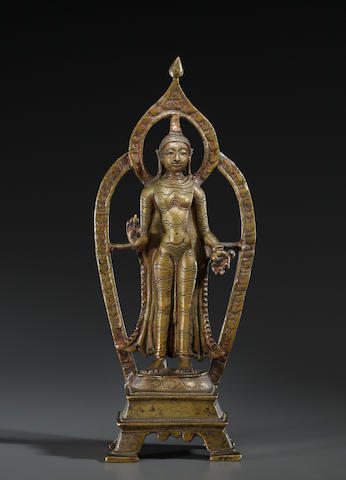
Kashmir or Himachal Pradesh, circa 11th century
Sold for US$ 22,500 (CA$ 27,992) inc. premium
INDIAN, HIMALAYAN & SOUTHEAST ASIAN ART
17 Sep 2014, 13:00 EDT
NEW YORK
LOT DETAILS
A copper alloy figure of Buddha
Kashmir or Himachal Pradesh, circa 11th century
Standing on a footed base and surrounded by a trefoil flaming mandorla, with his outer robe wrapping around his slender figure and flaring outwards, his right hand displaying the gesture of assurance, his face with classic broad lips, nose, eyes, and urna.
12 1/8 in. (30.5 cm) high
FOOTNOTES
A rare example of Buddhist bronzes produced in Northwestern India during the 11th and 12th centuries, the present lot exhibits a number of features that draw close comparison with an example from Kashmir sold at Sotheby’s, London, 13 June 1988, lot 58 and another from and Himachal Pradesh published in von Schroeder, Indo-Tibetan Bronzes, Hong Kong, 1981, p. 155, no. 29D.
During the 11th and 12th centuries, patrons of the Guge Kingdom in West Tibet commissioned experienced Kashmiri and Himachal Pradesh craftsmen to produce Buddhist bronzes. Following the Udayana stylistic type, with incised psueo-concentric folds descending from the neck, this bronze represents an amalgamation of Kashmiri and Himachal Pradesh sculptural traditions. The type is closely related to Buddha images produced in Ladakh in the 12th century, an example of which is published in Singh, Himayalan Art, London, 1971, p. 55.
Provenance:
Private London Collection since 1980s
5th century, Jammu Kashmir or Pakistan,
Avalokiteshvara, copper alloy, 12 cm,
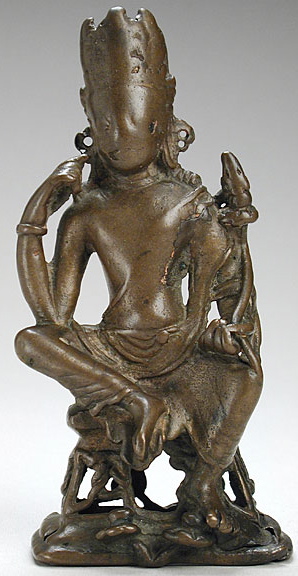
5th century, Jammu Kashmir, Maitreya sitting on lotus, copper alloy, at Los Angeles County Museum of Art
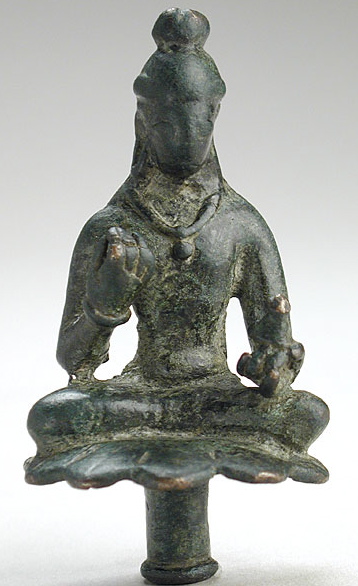
11th-12th century, Kashmir, Shakyamuni, brass,
private collection, photo by Christie’s
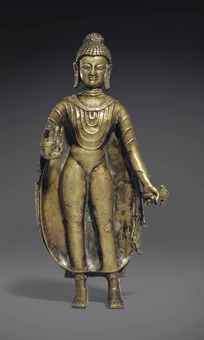
Sometimes, the folds at the front of the buddha’s robe are U-shaped (marked all the way up to the collar).
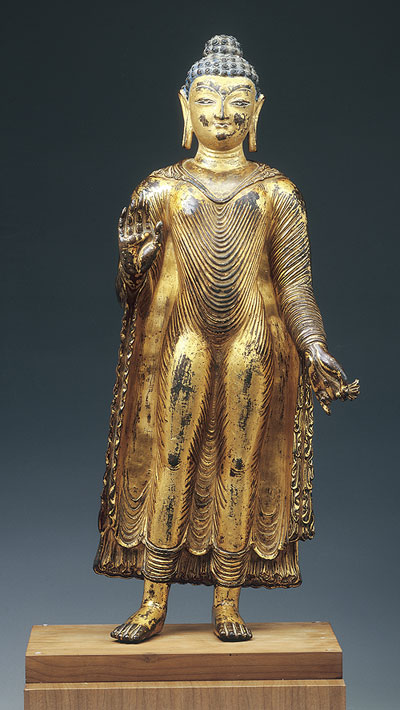
高63厘米
西藏博物馆藏
释迦牟尼佛像身披袈裟,右手举于胸前施无畏印,左手微提袈裟。袈裟的主体以同心圆状的波浪纹表现。相传最初佛教信徒请画师为释迦牟尼画像时,由于释迦牟尼的光芒使画家不敢直视,只好通过水中的倒影来绘制,所以释迦牟尼的衣纹如水波涟漪。后来的很多释迦牟尼造像中衣纹都有水波纹。此造型体态优美,是克什米尔风格的佳作。

![[临渊阁]天地一家春](https://www.antiquekeeper.ca/wp-content/uploads/2023/03/cropped-Asian-Art-Wallpaper-Painting3-6-2.jpg)
